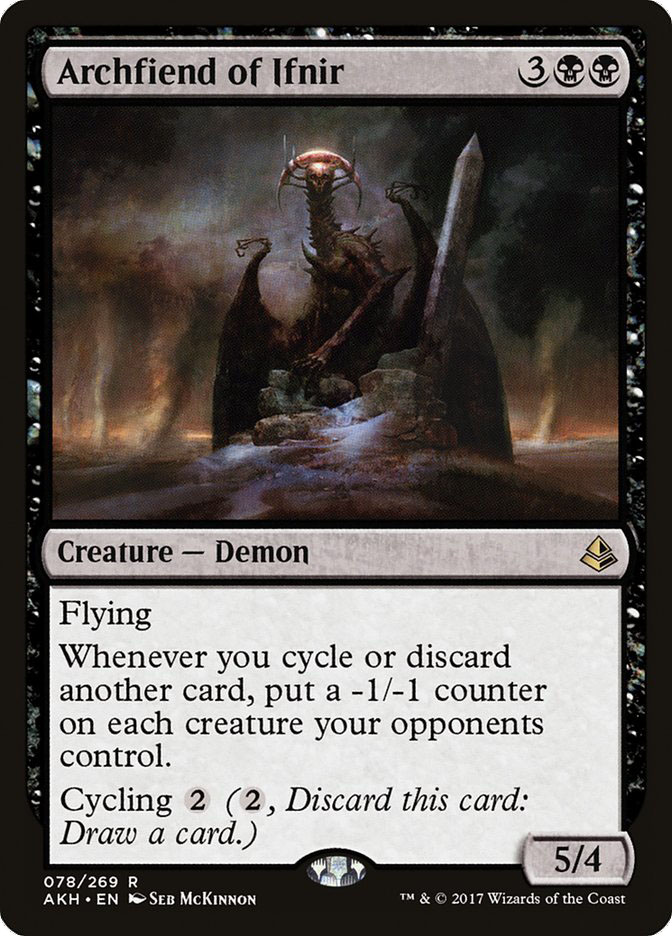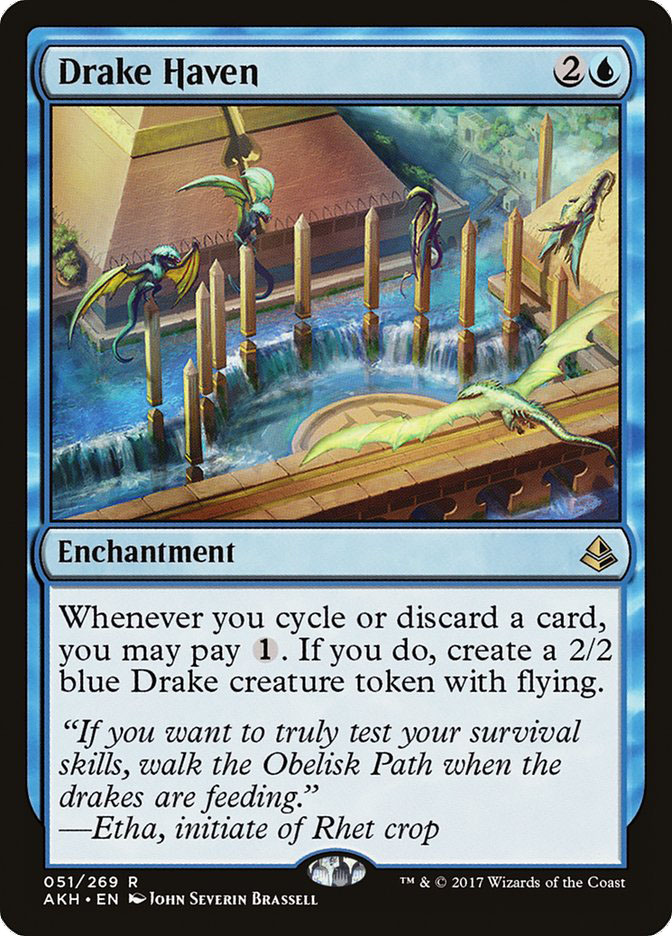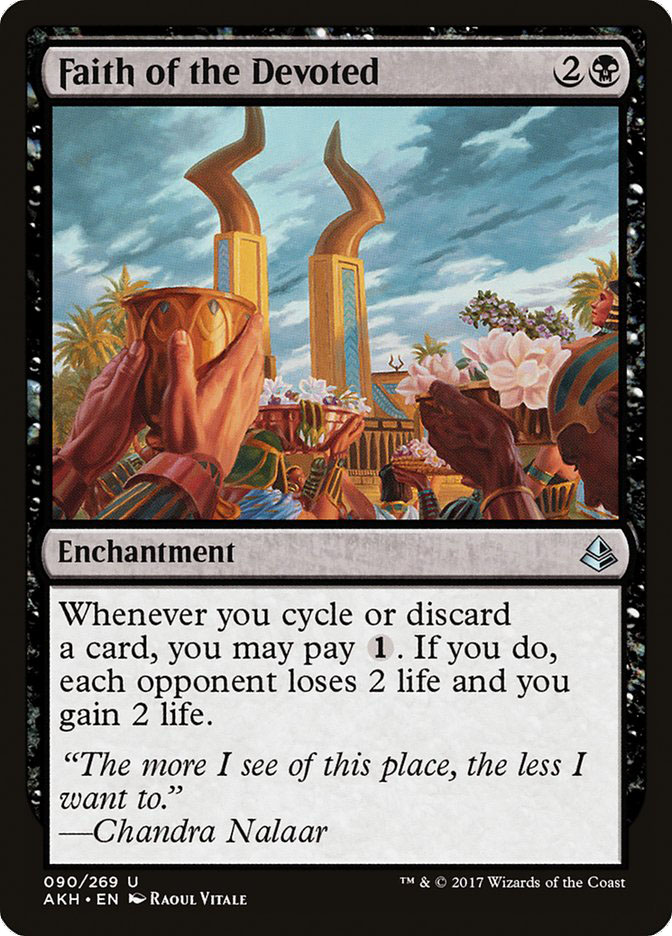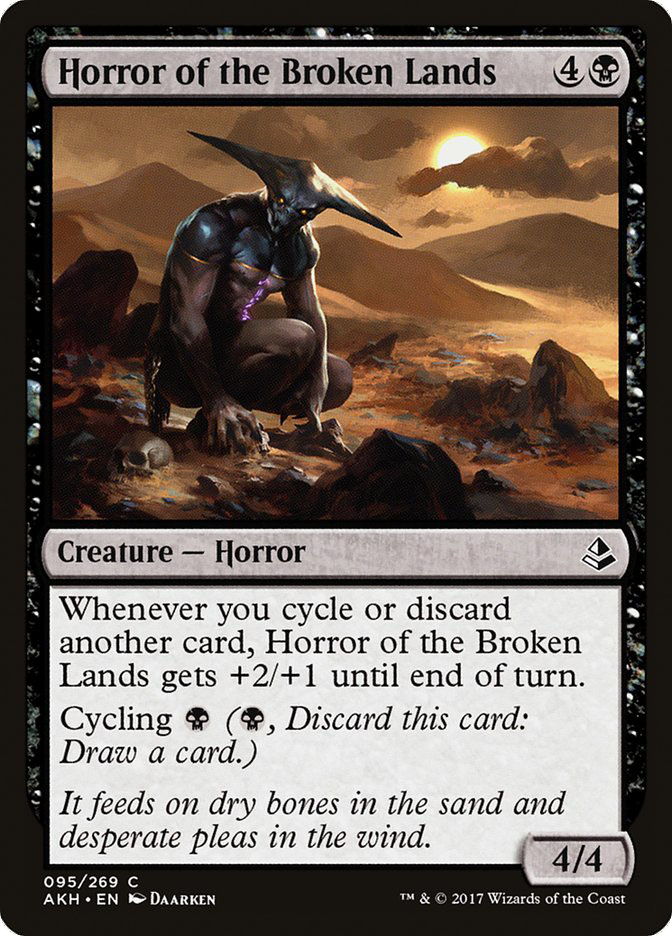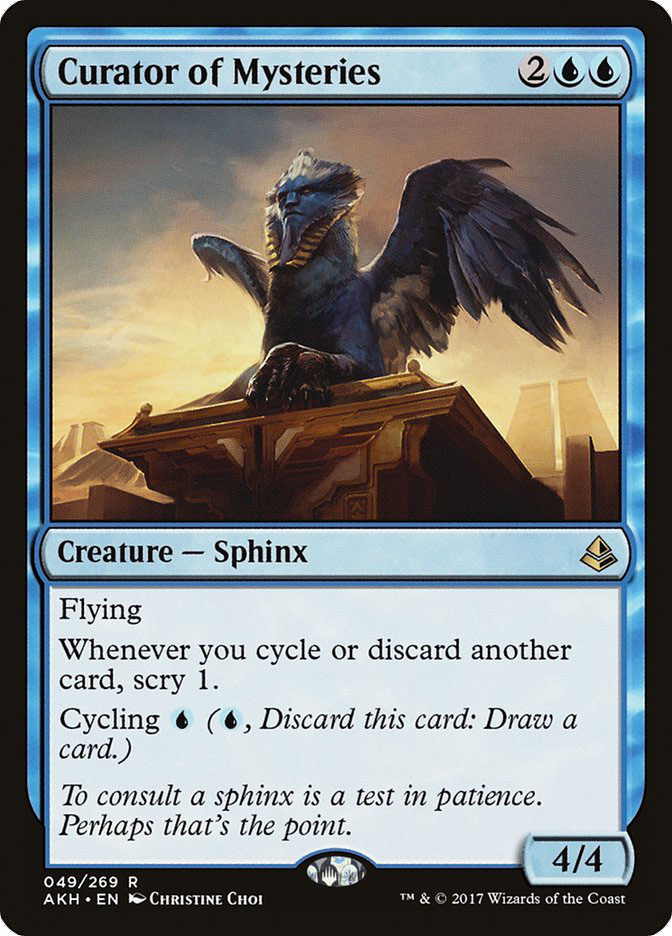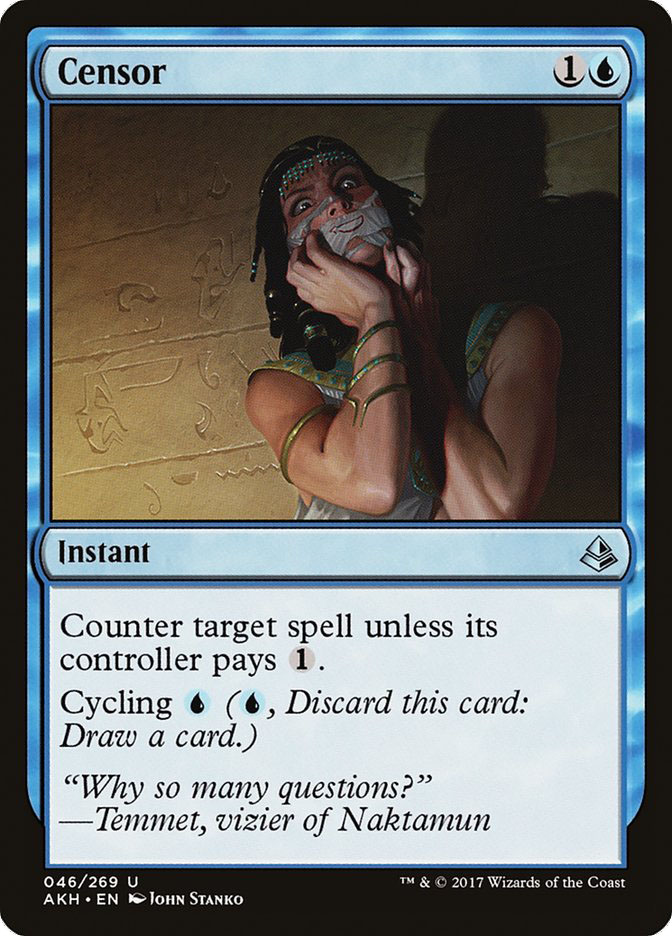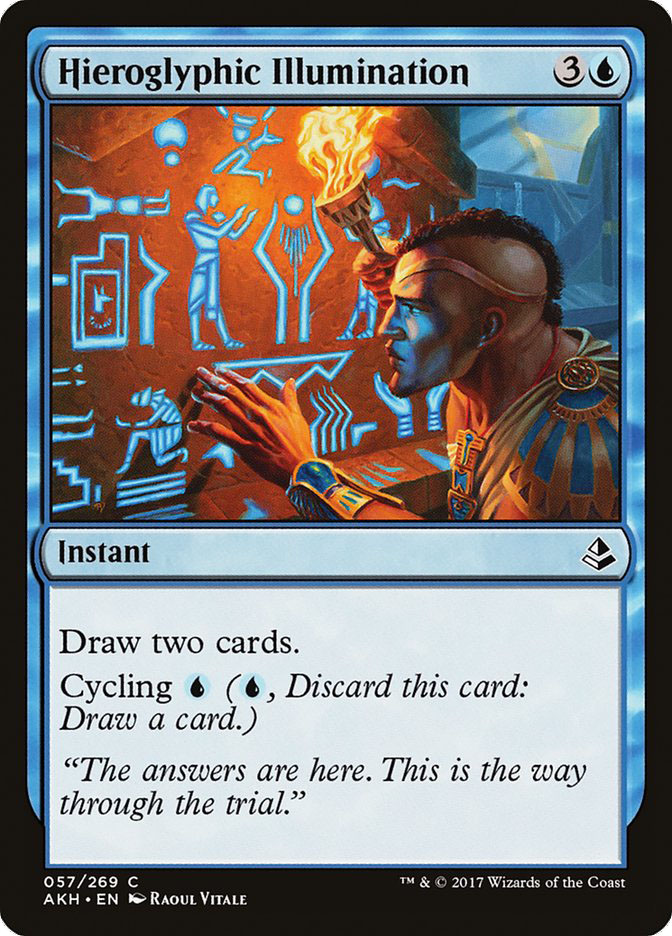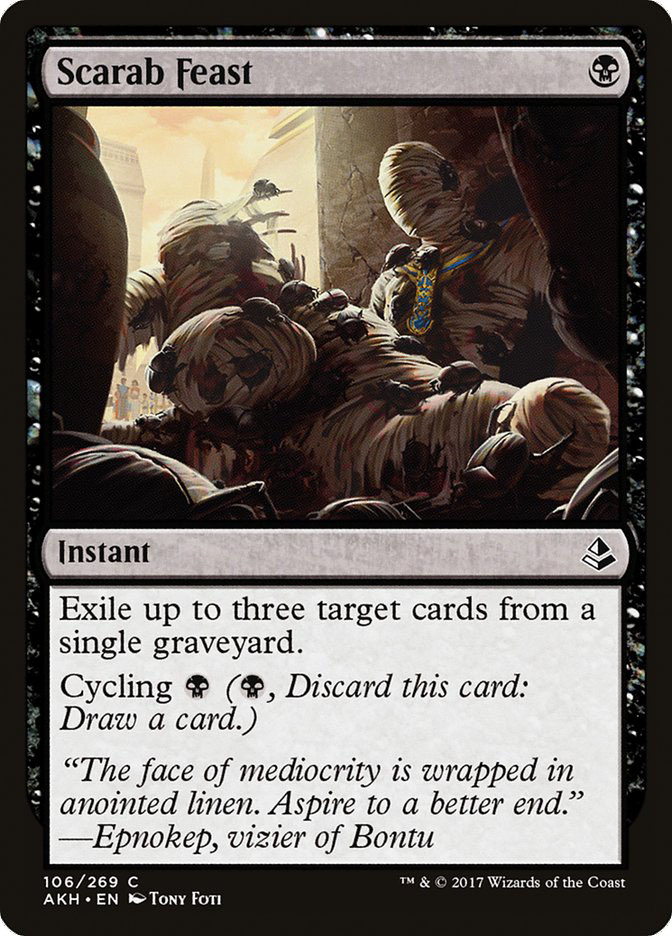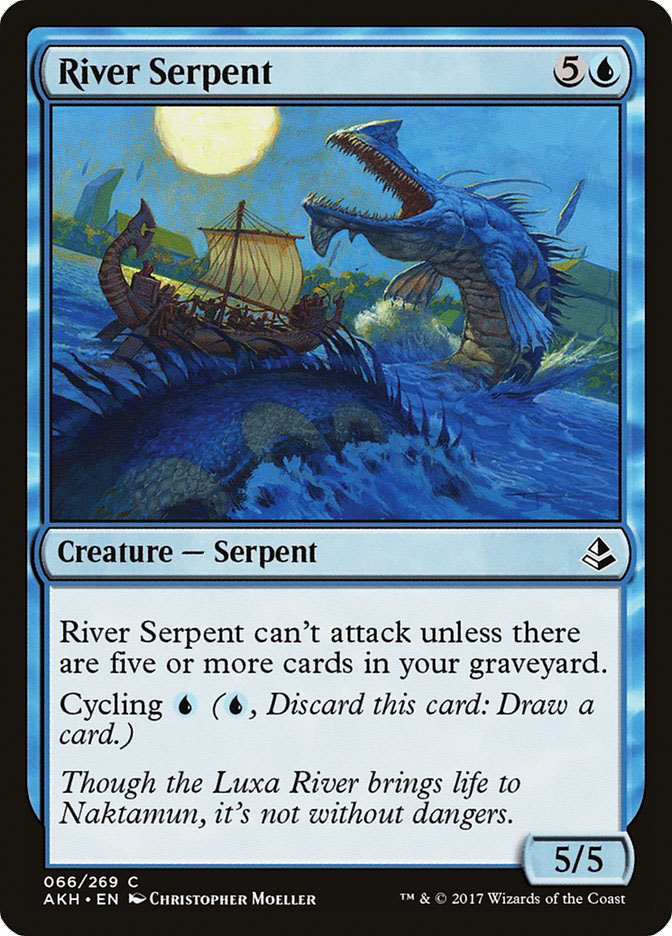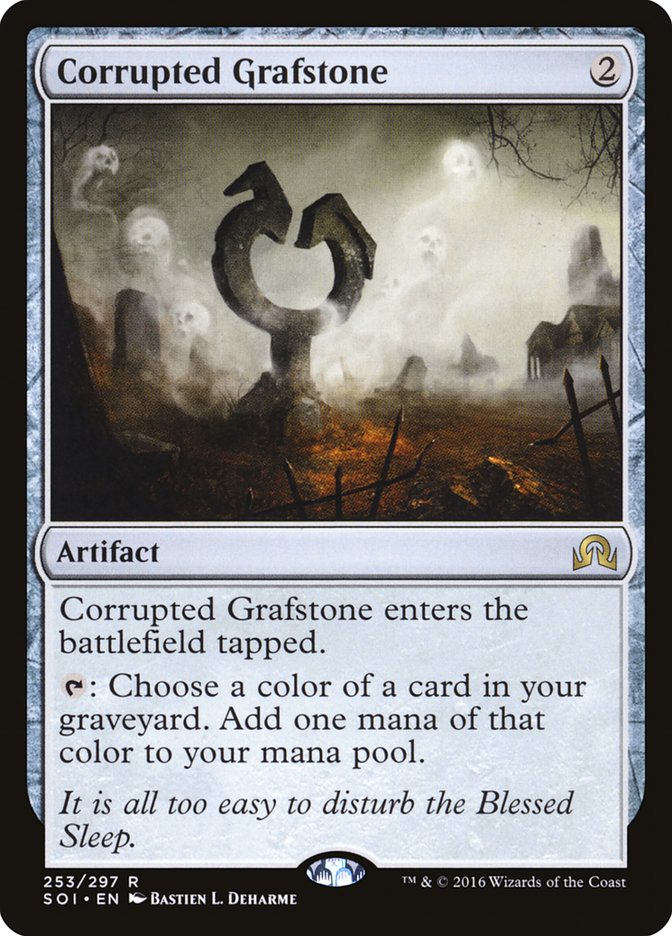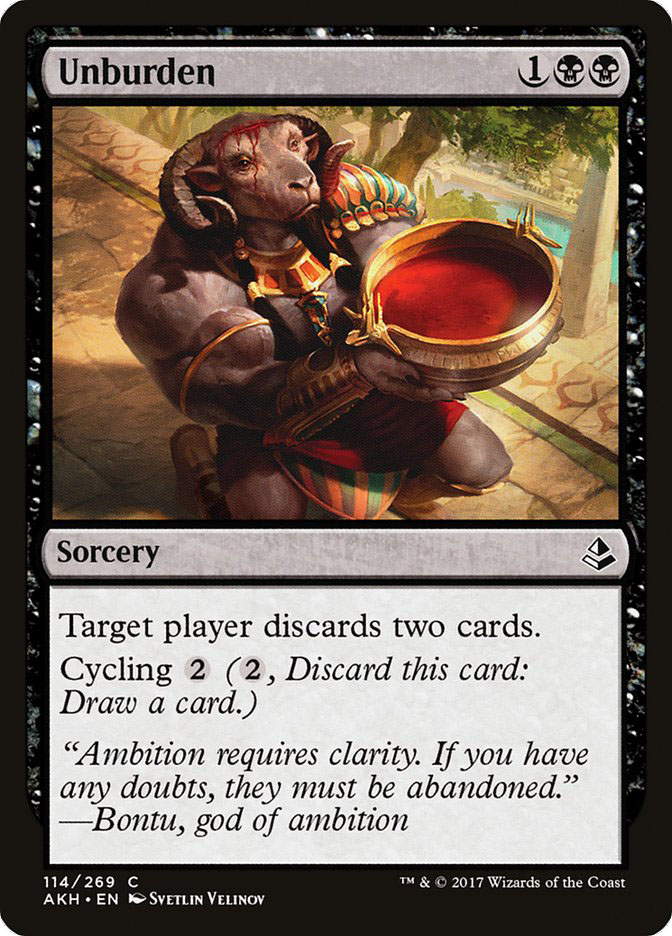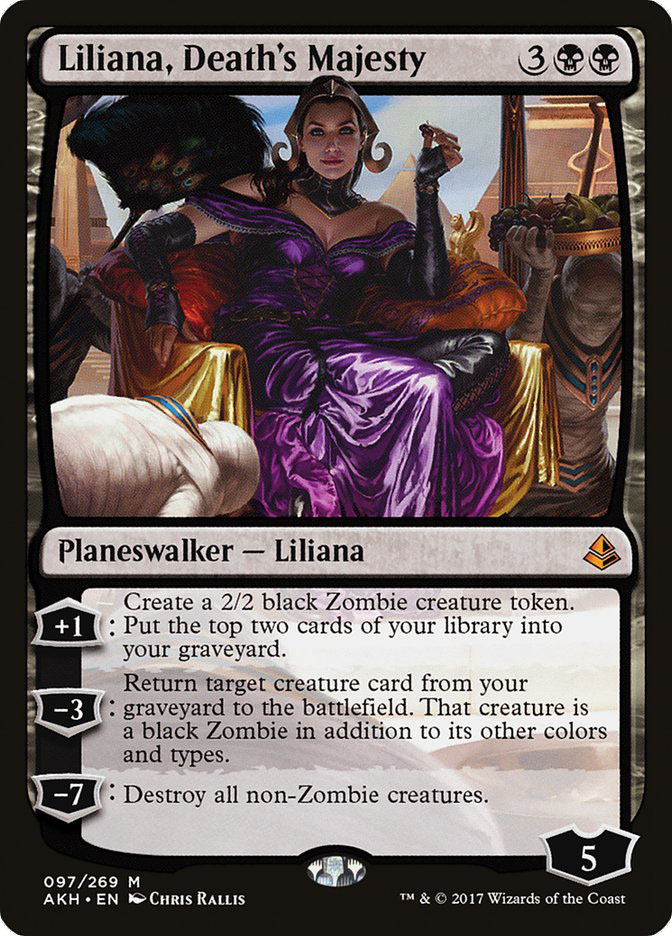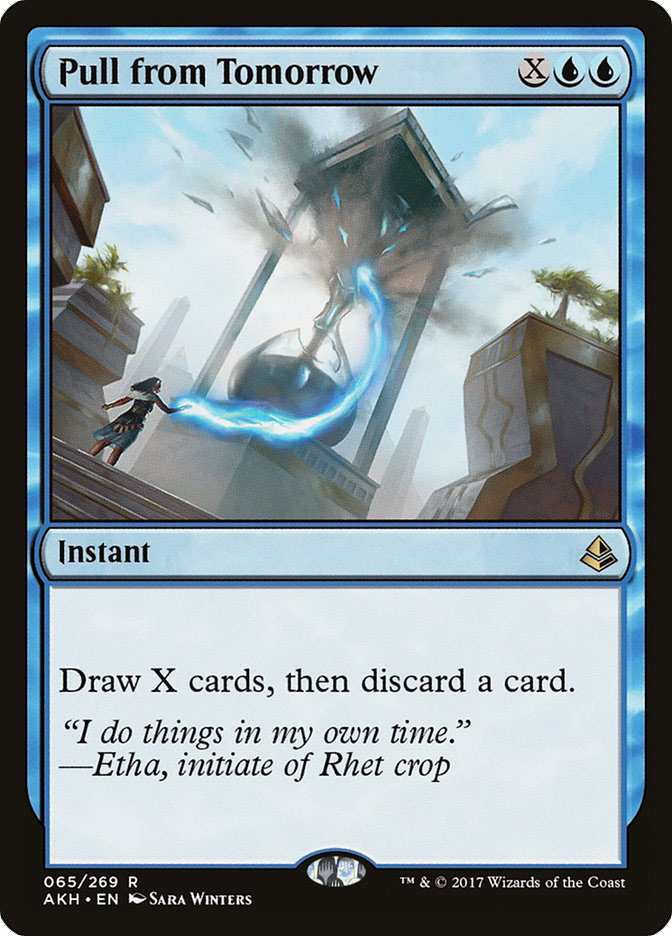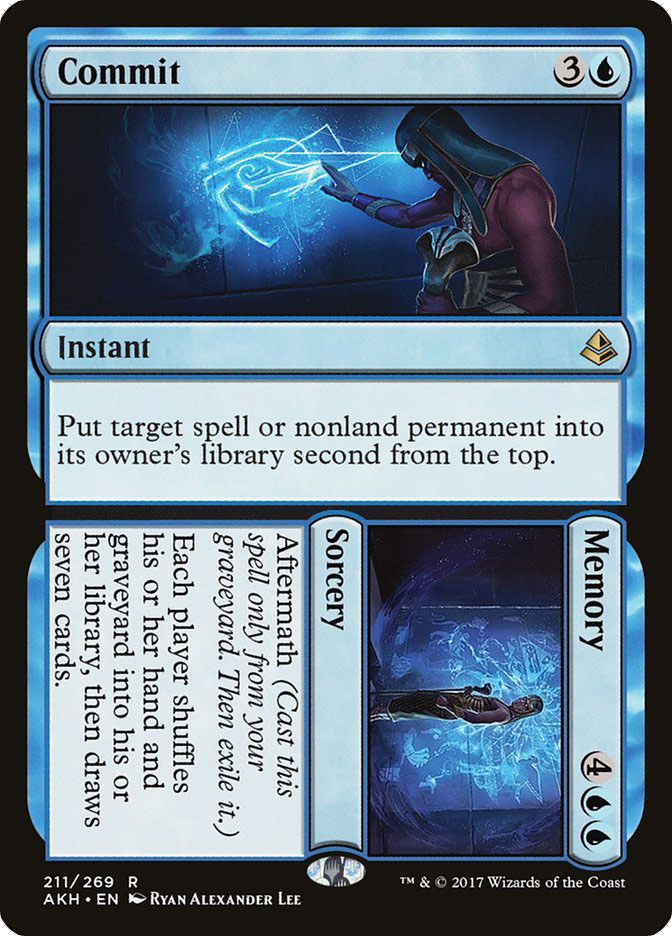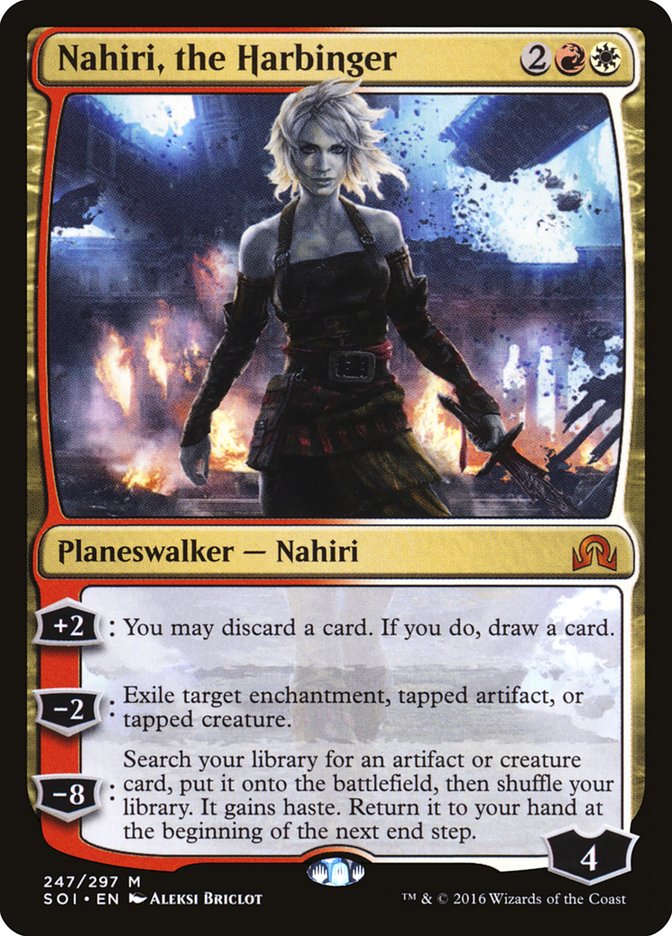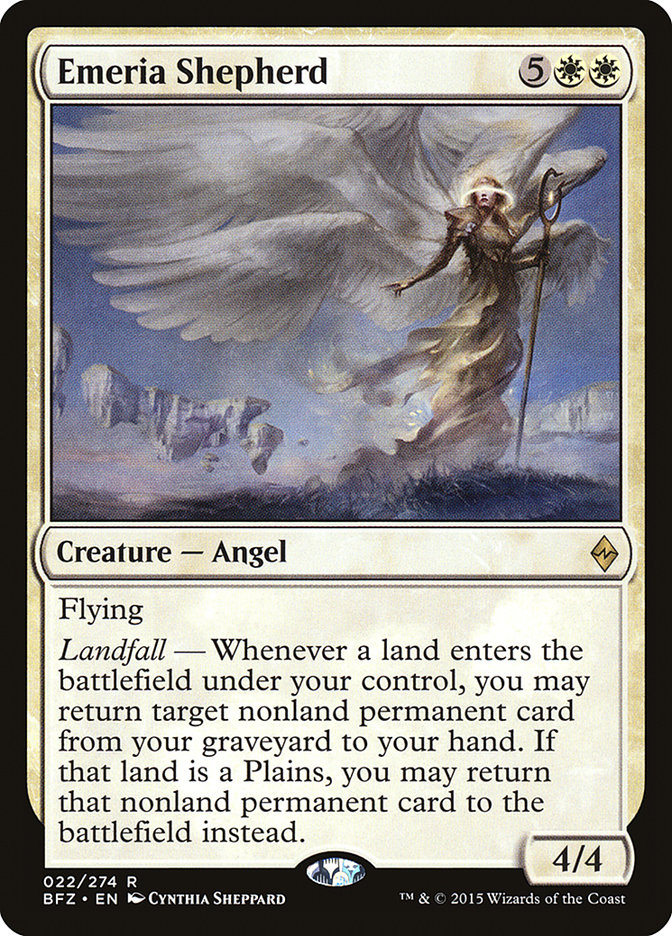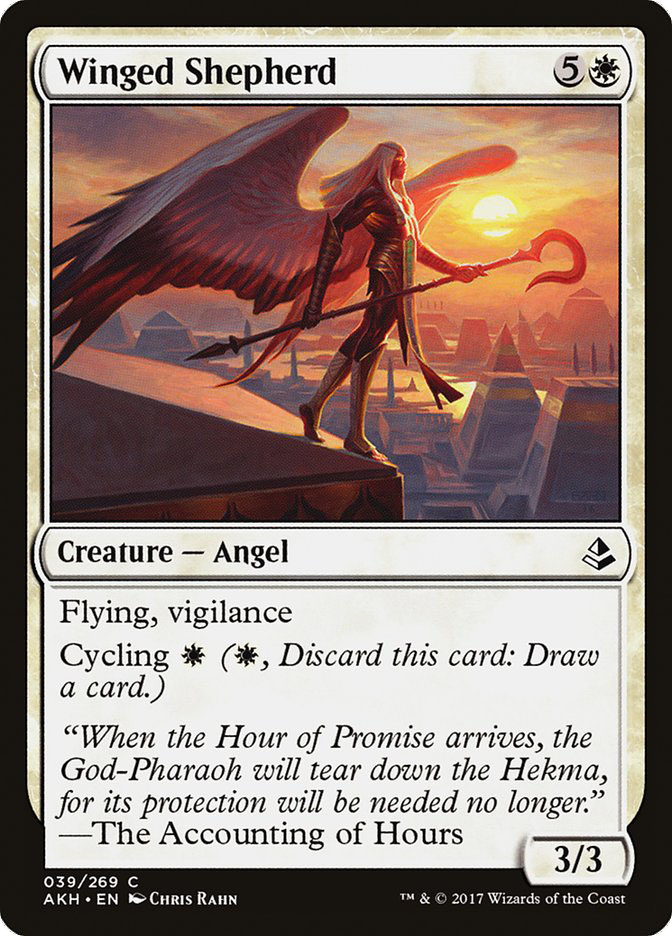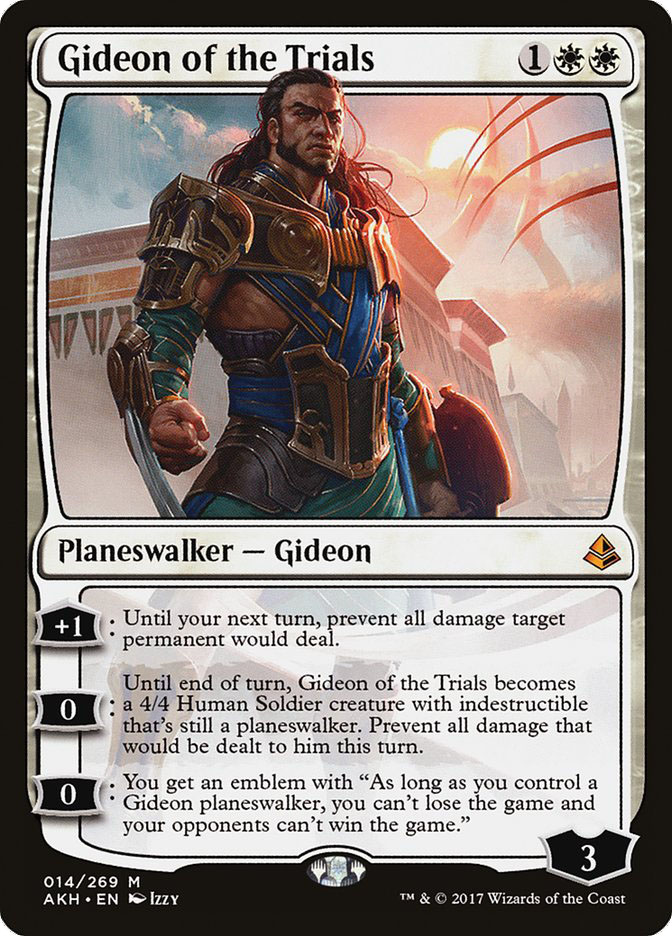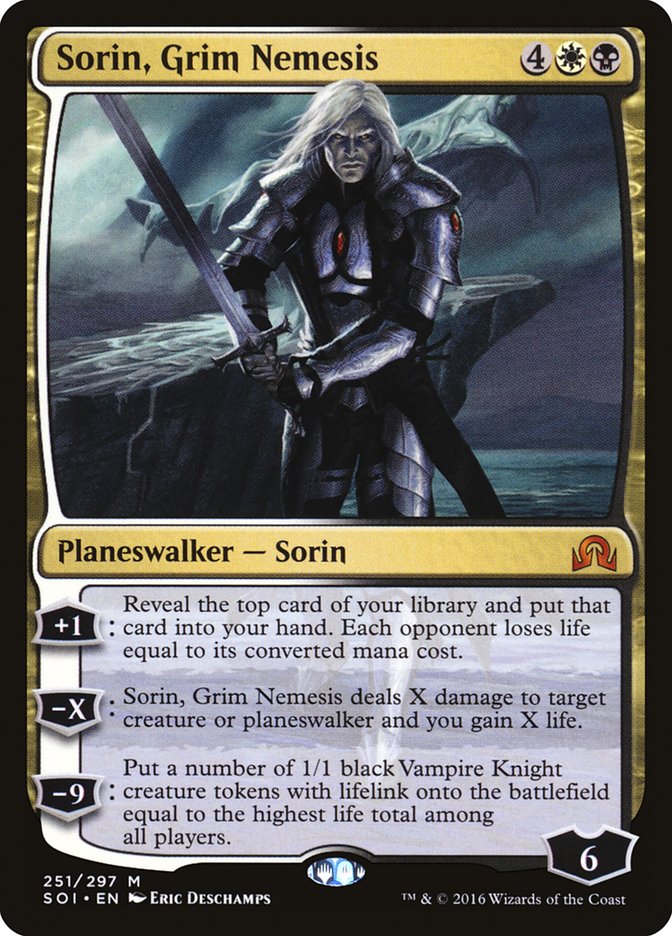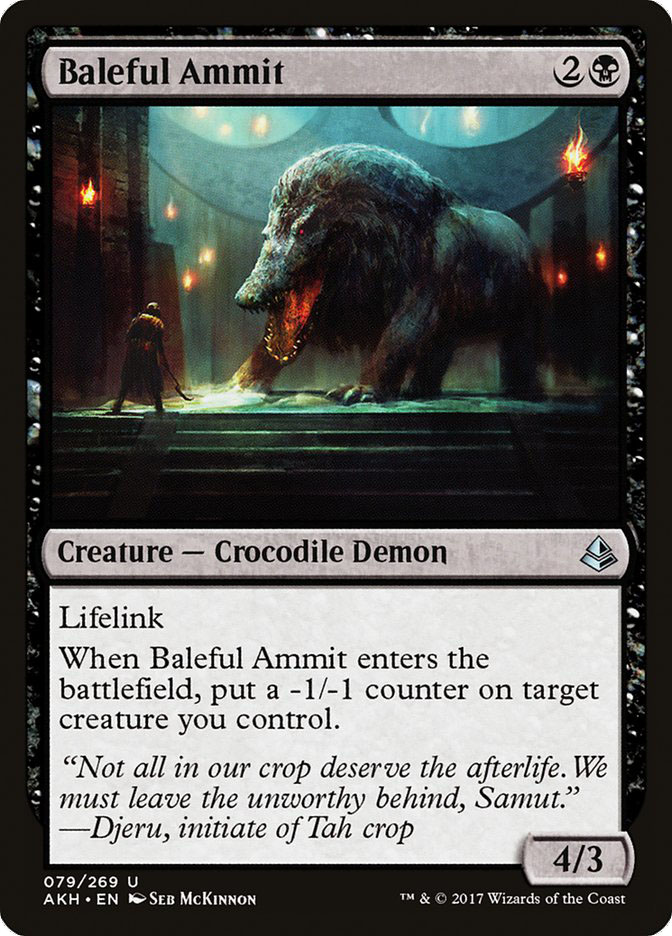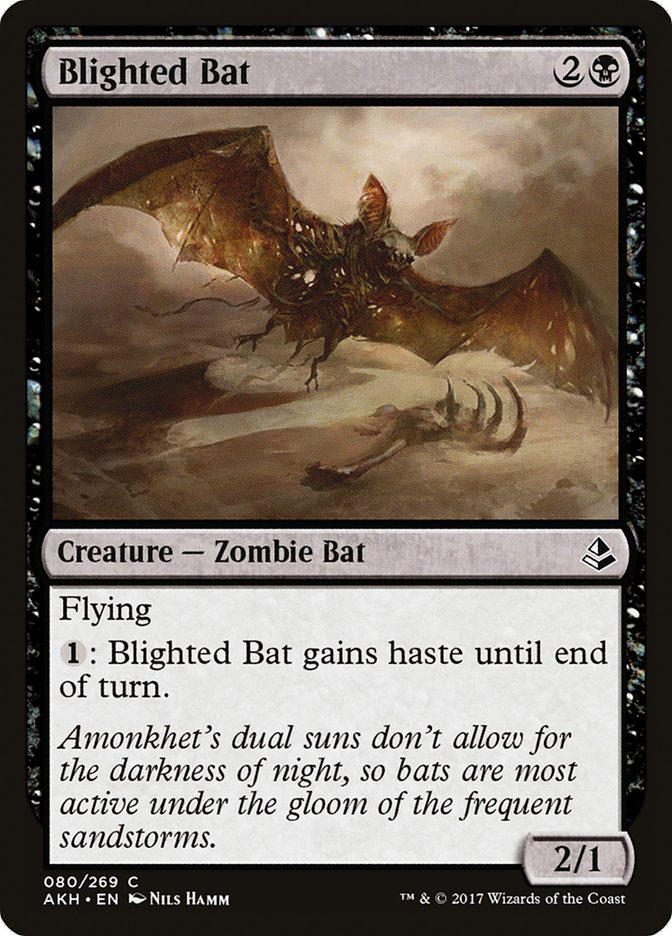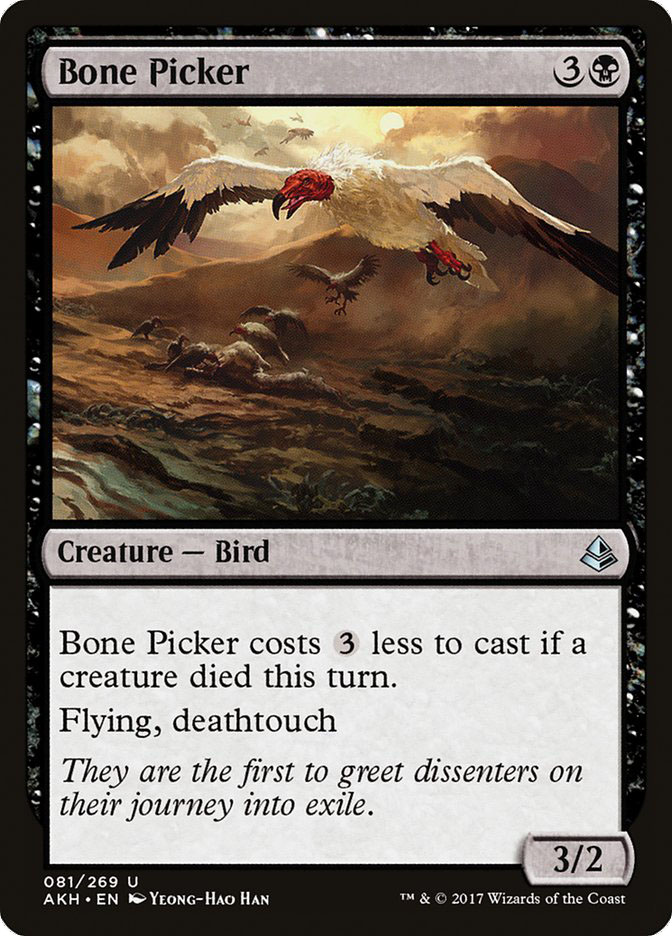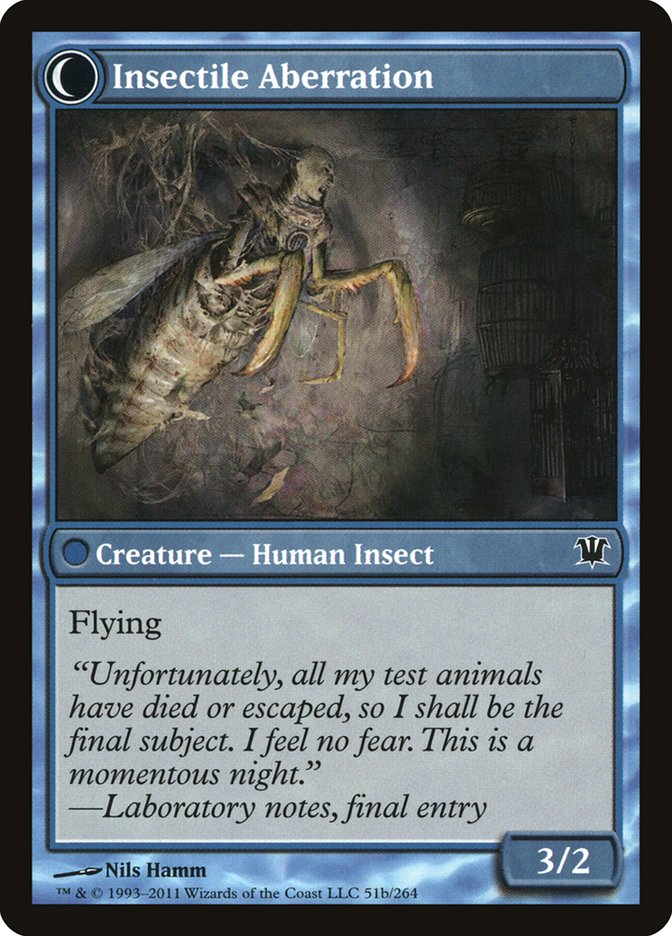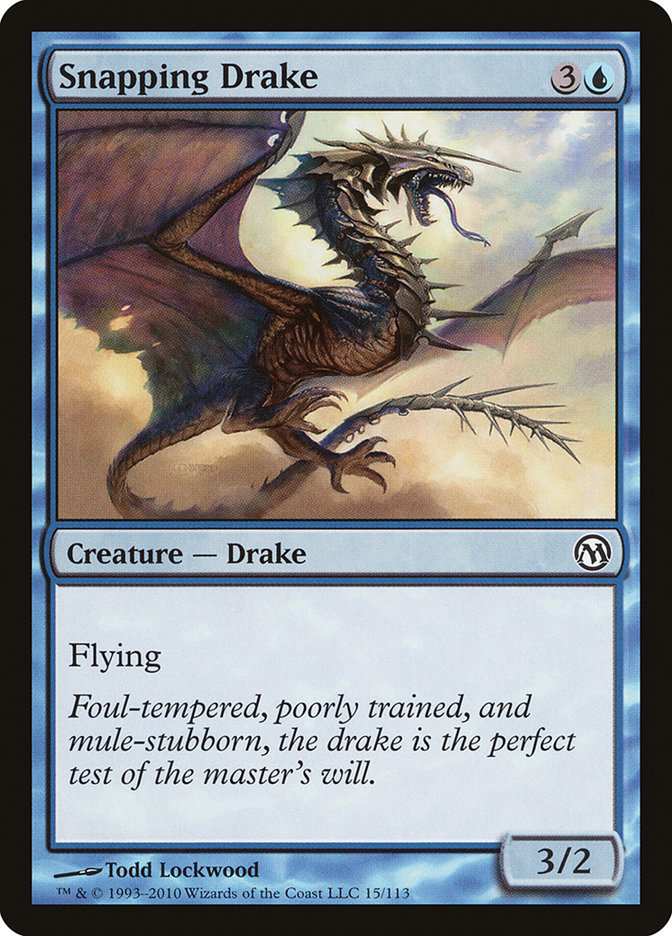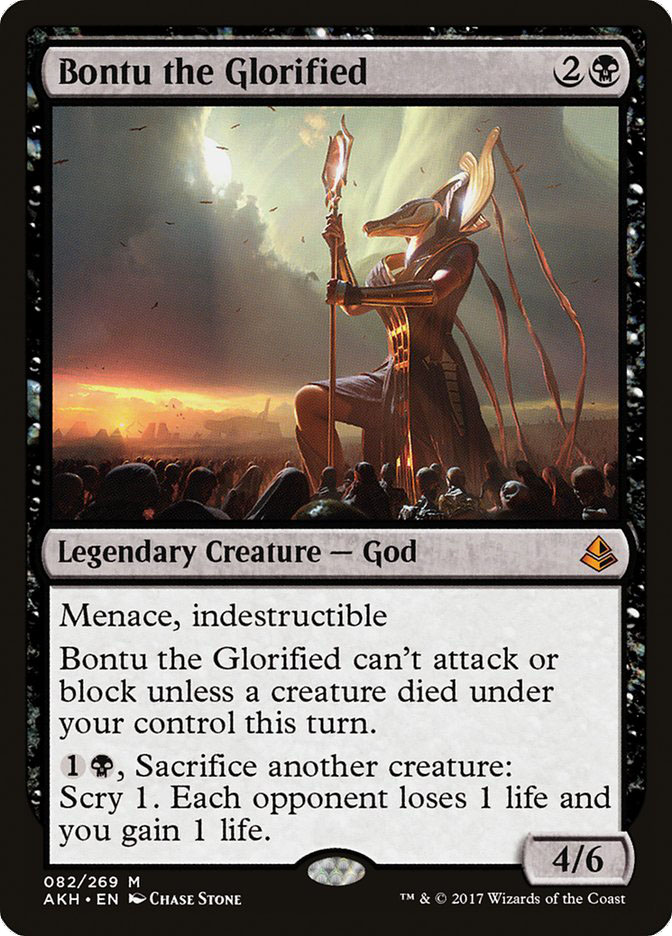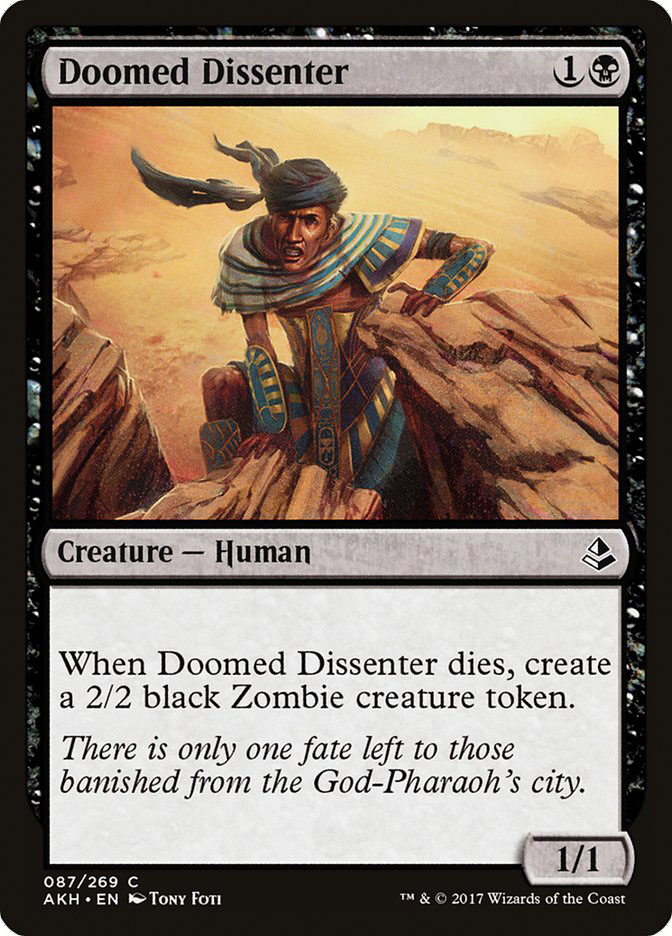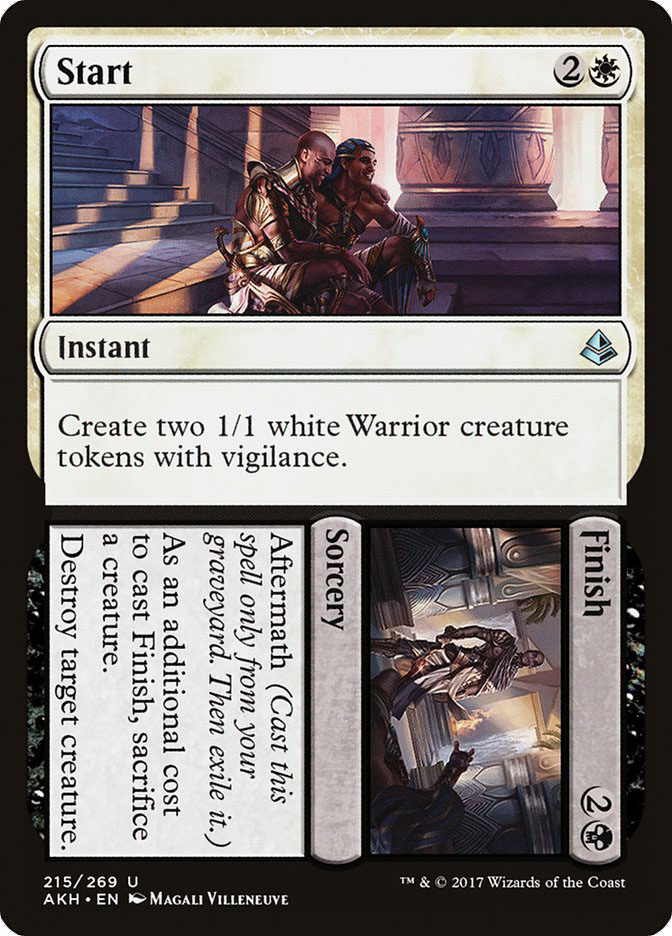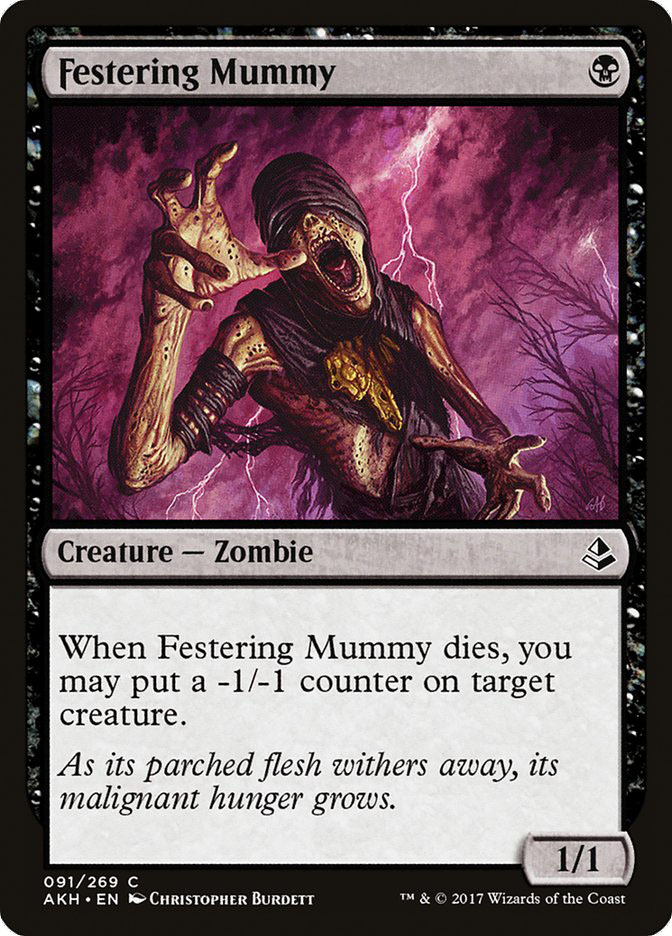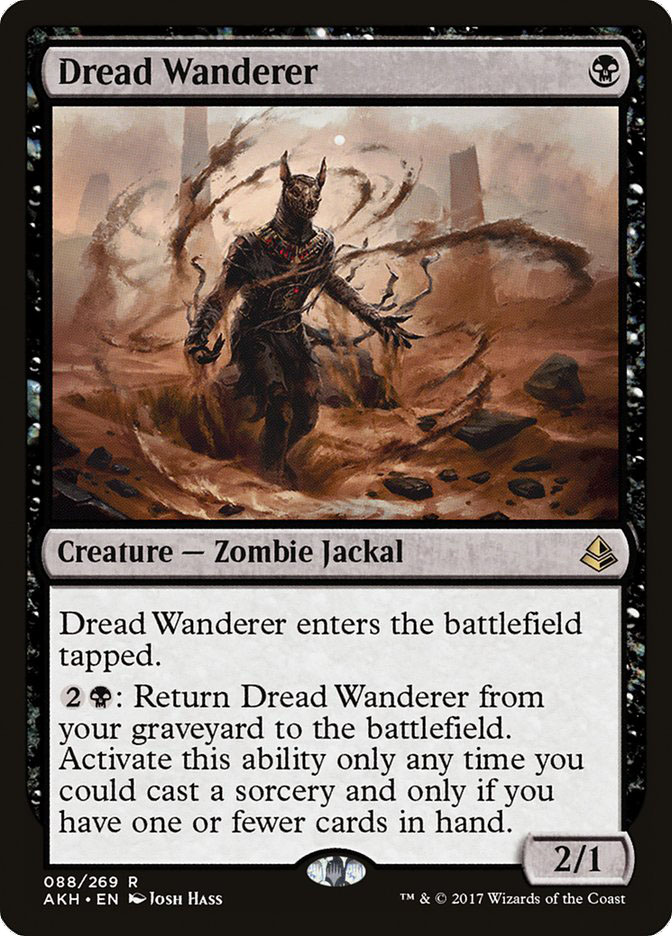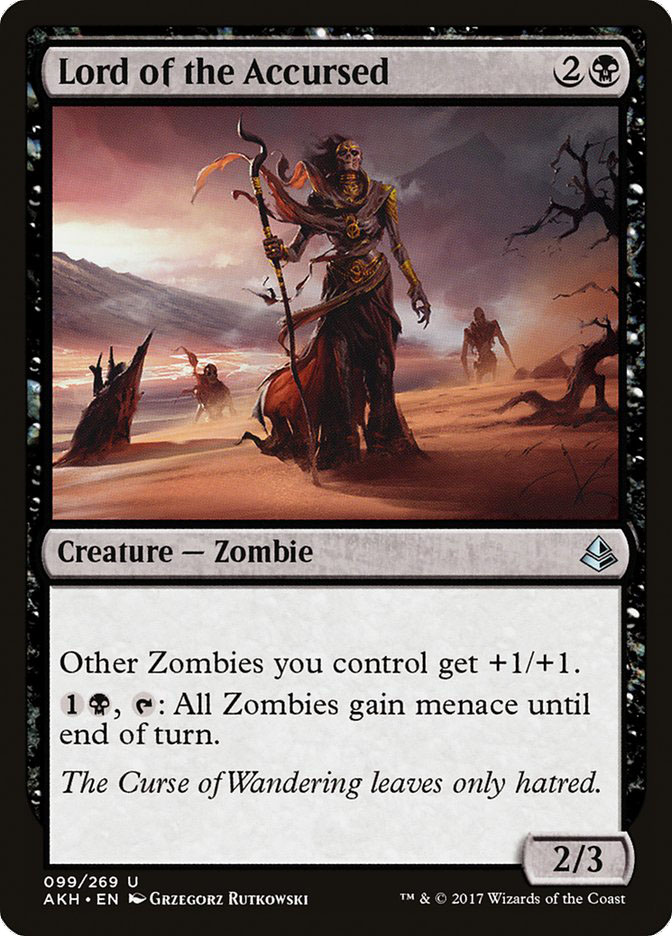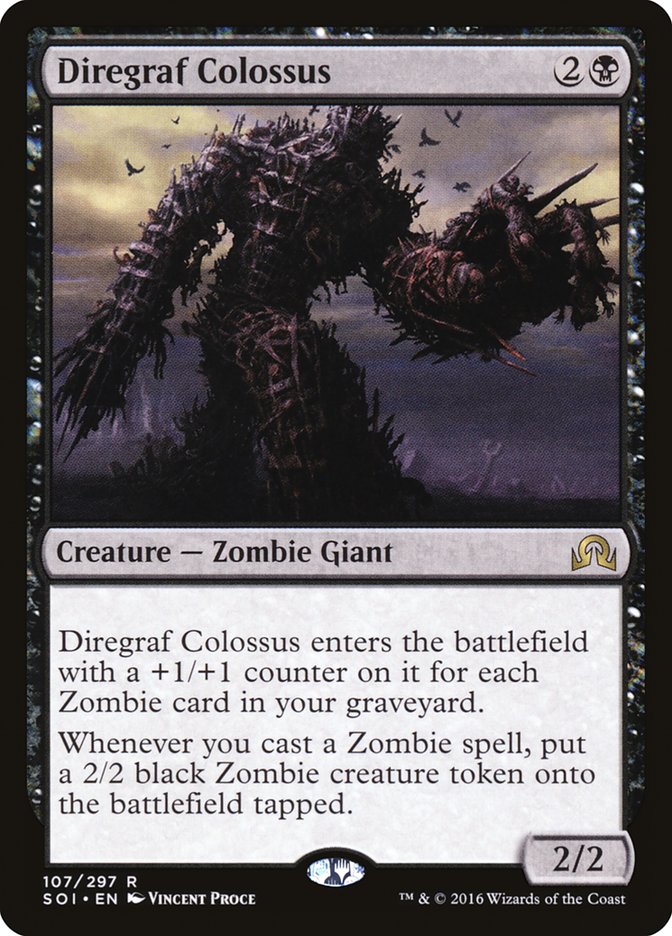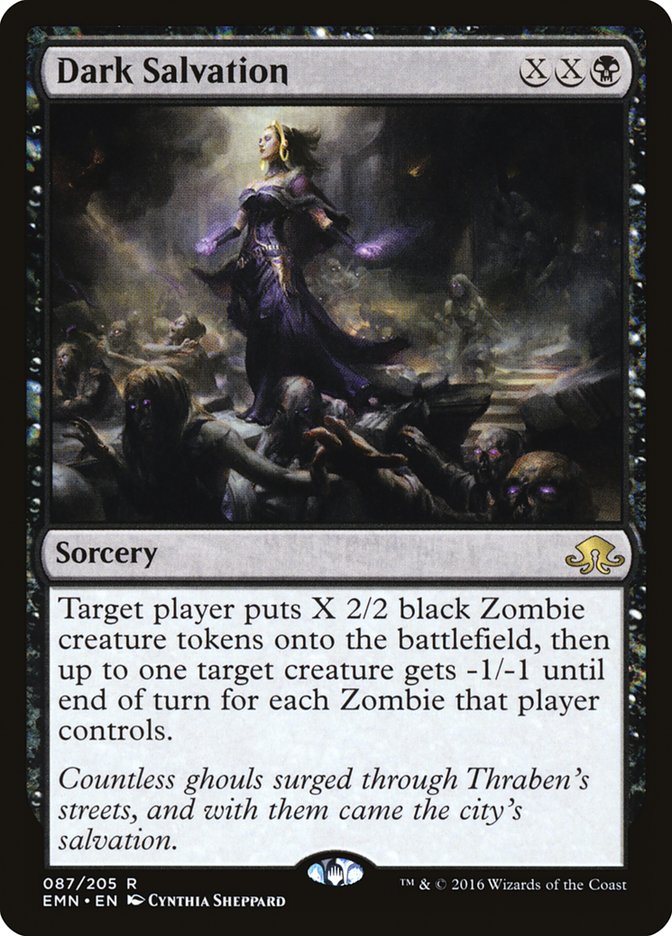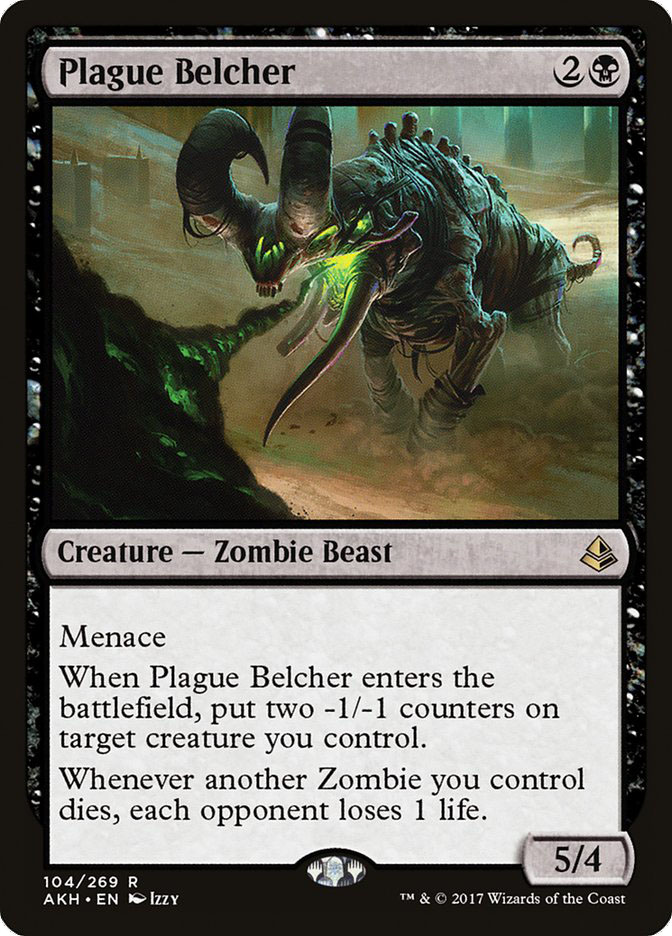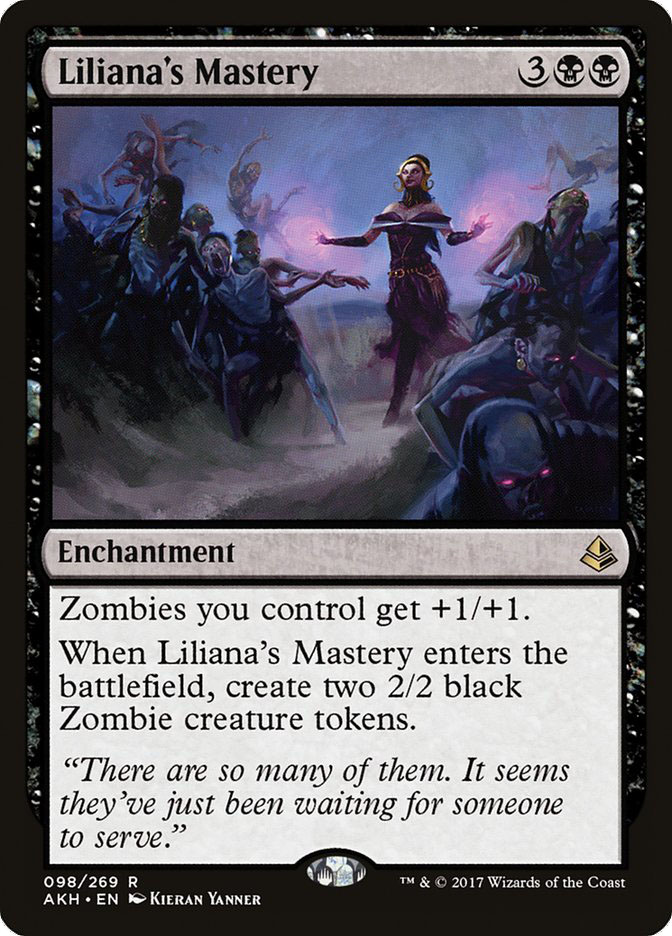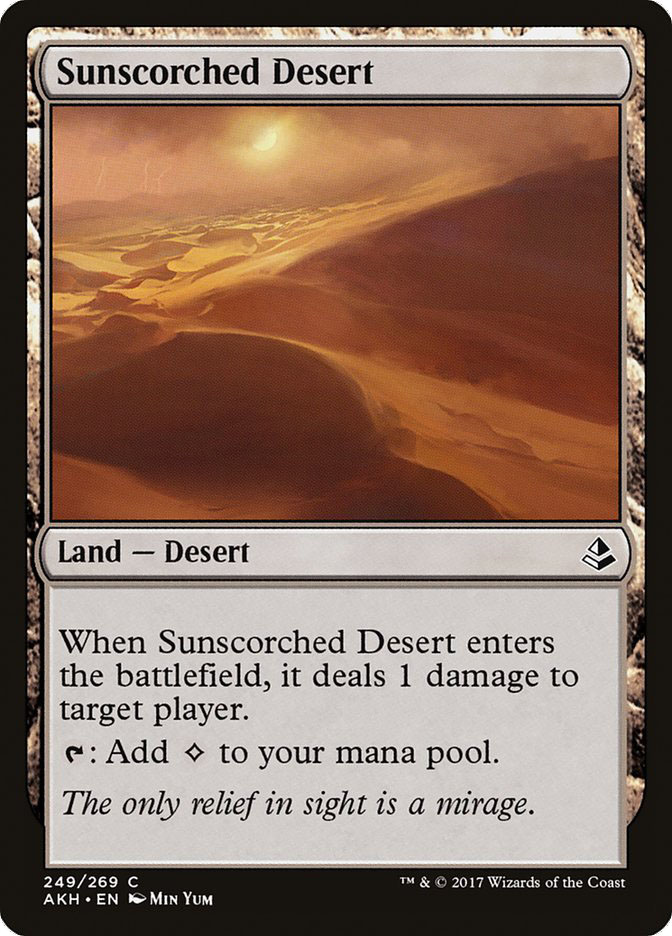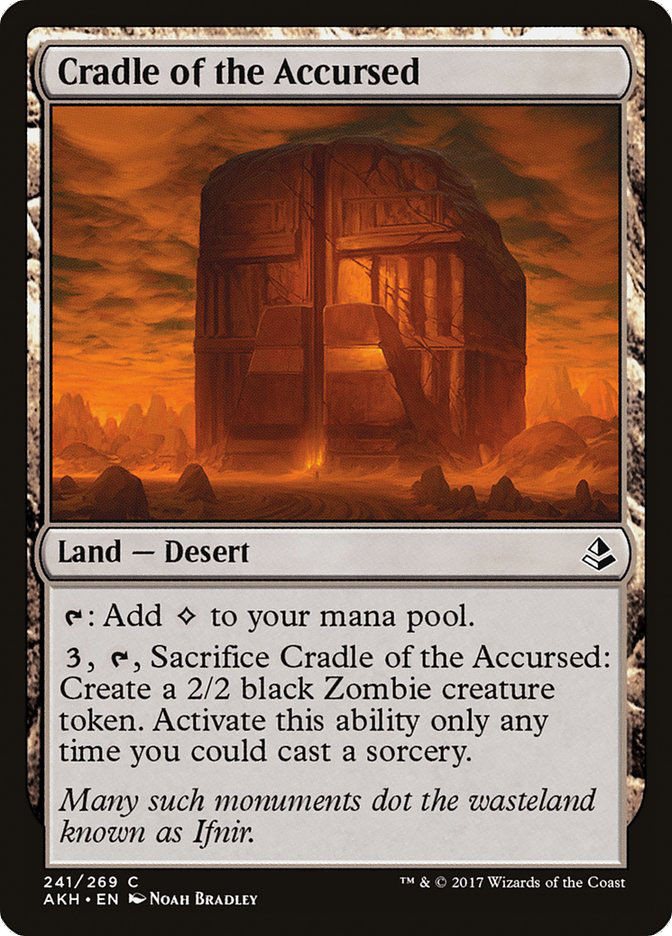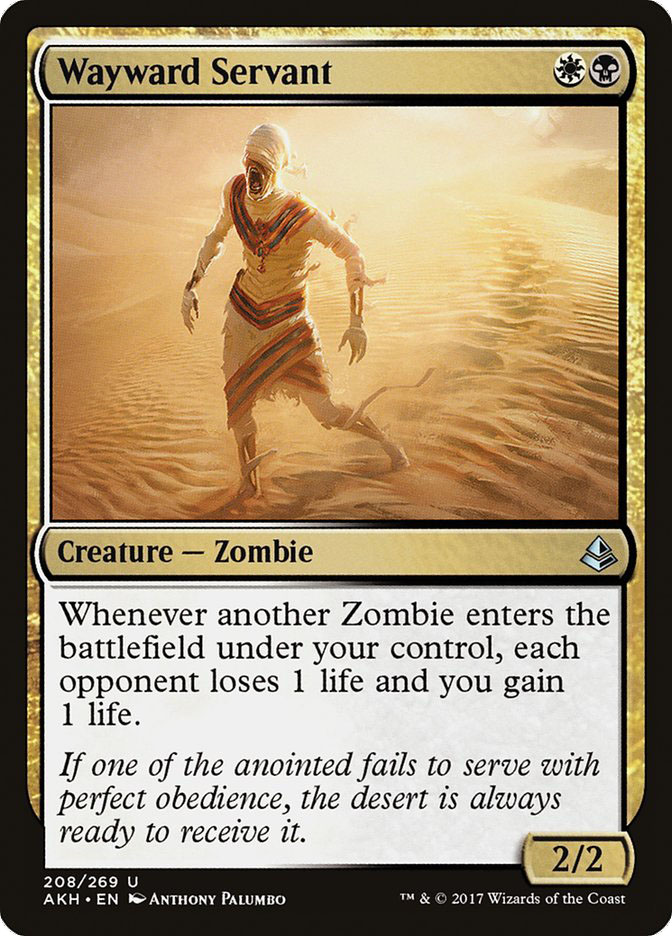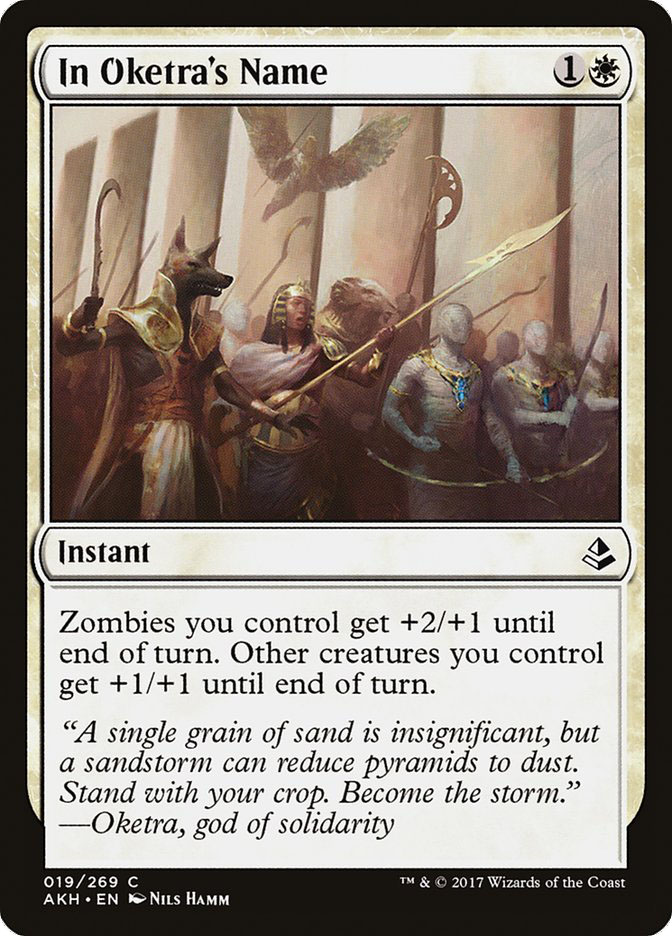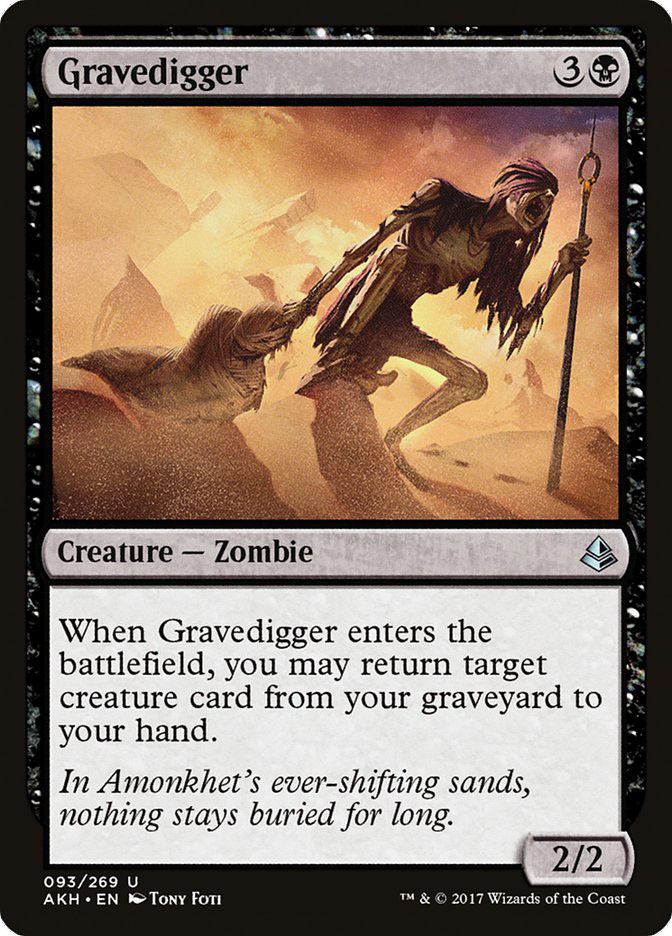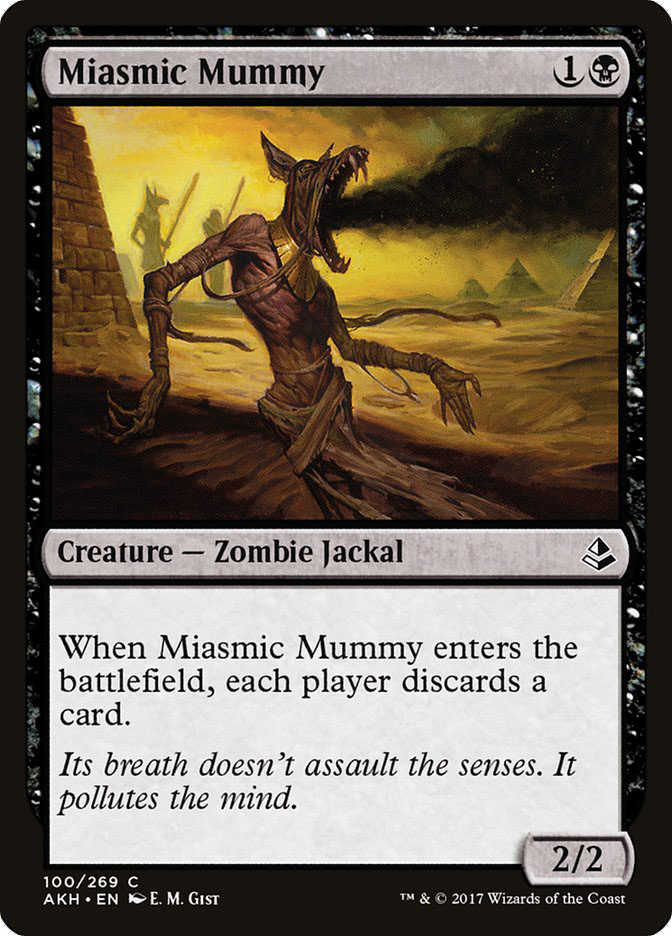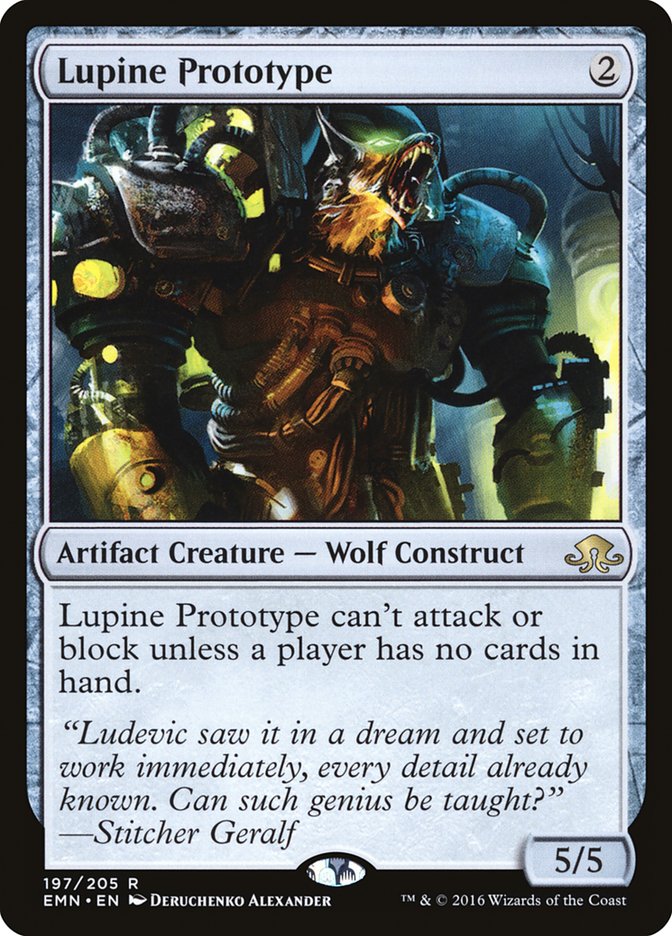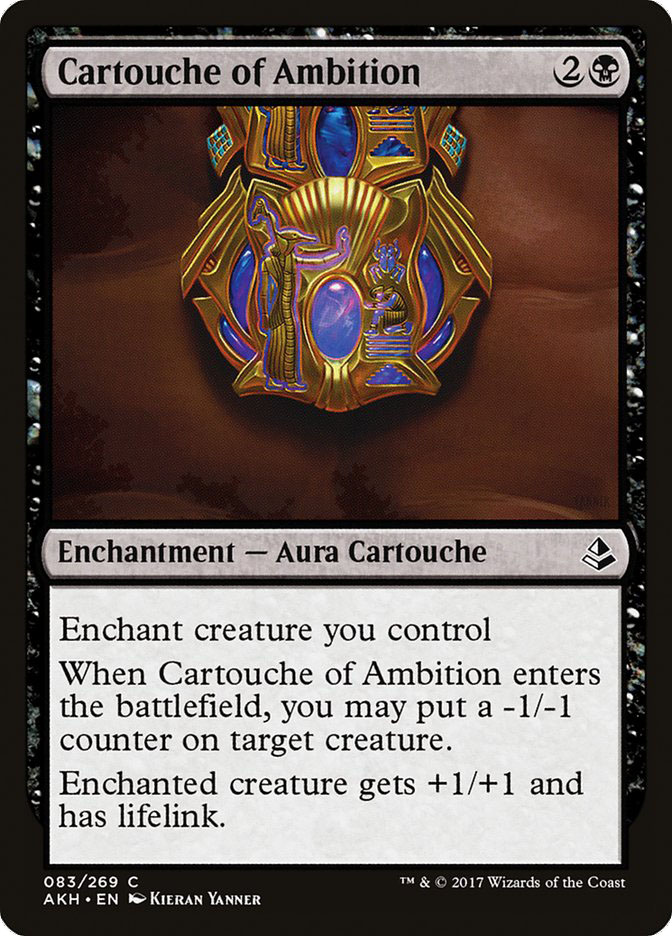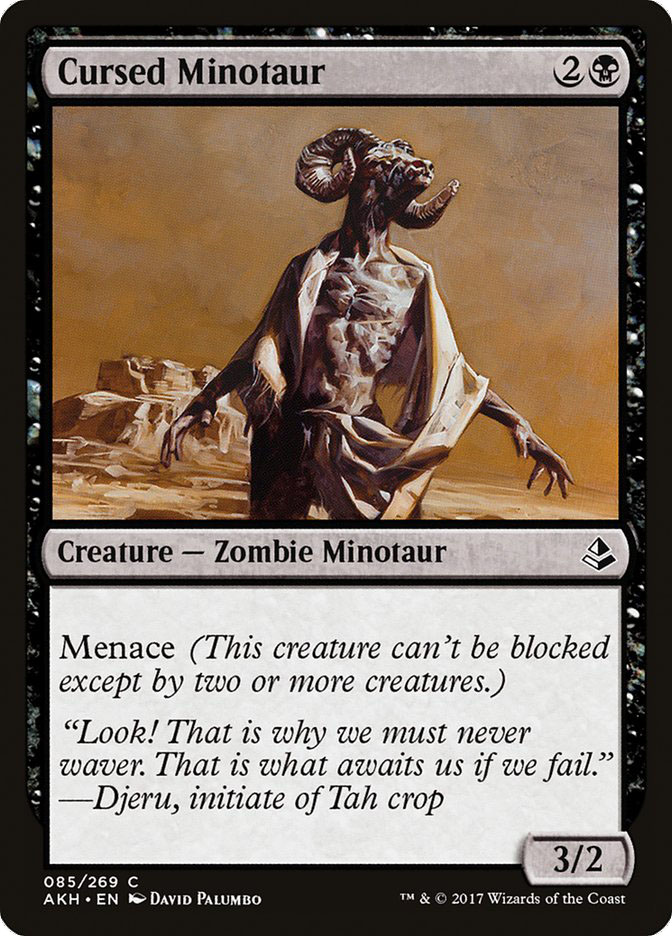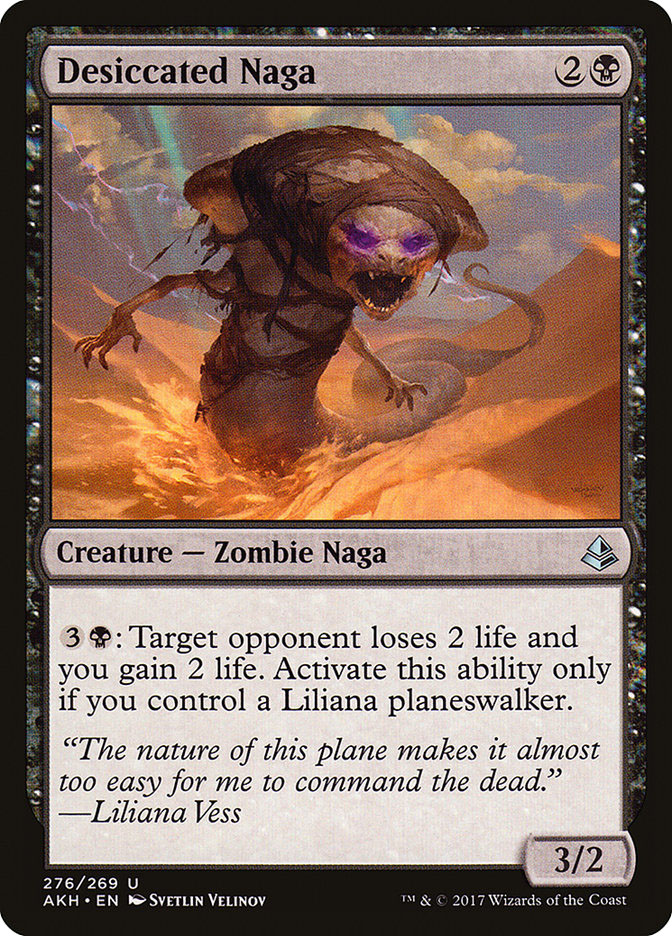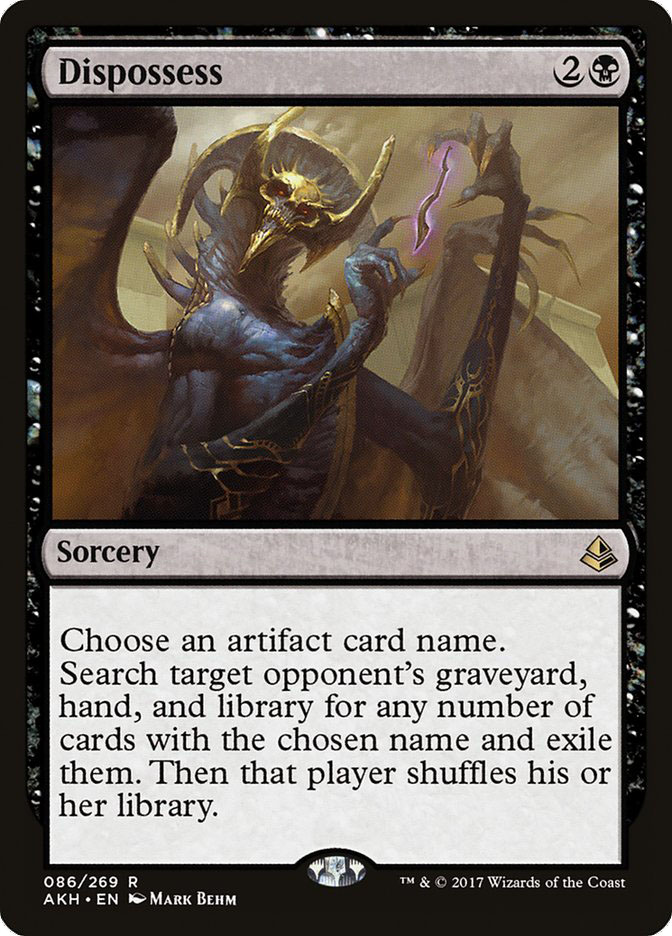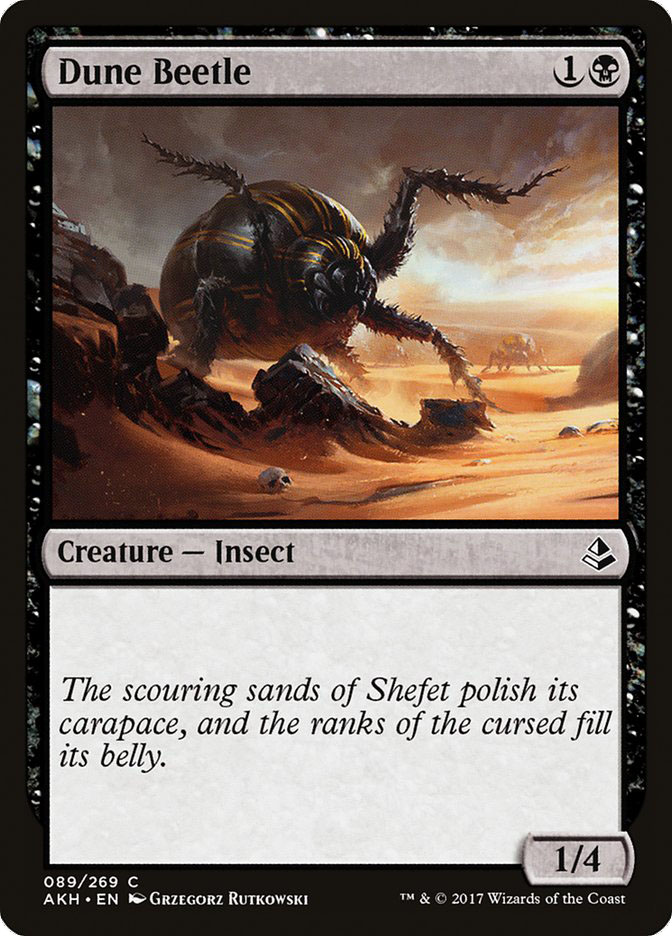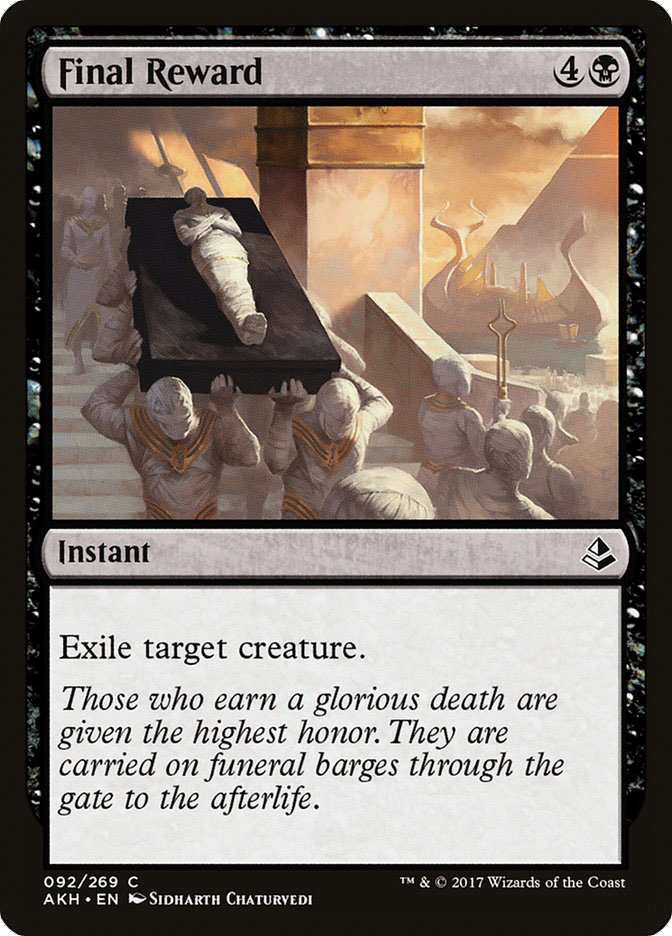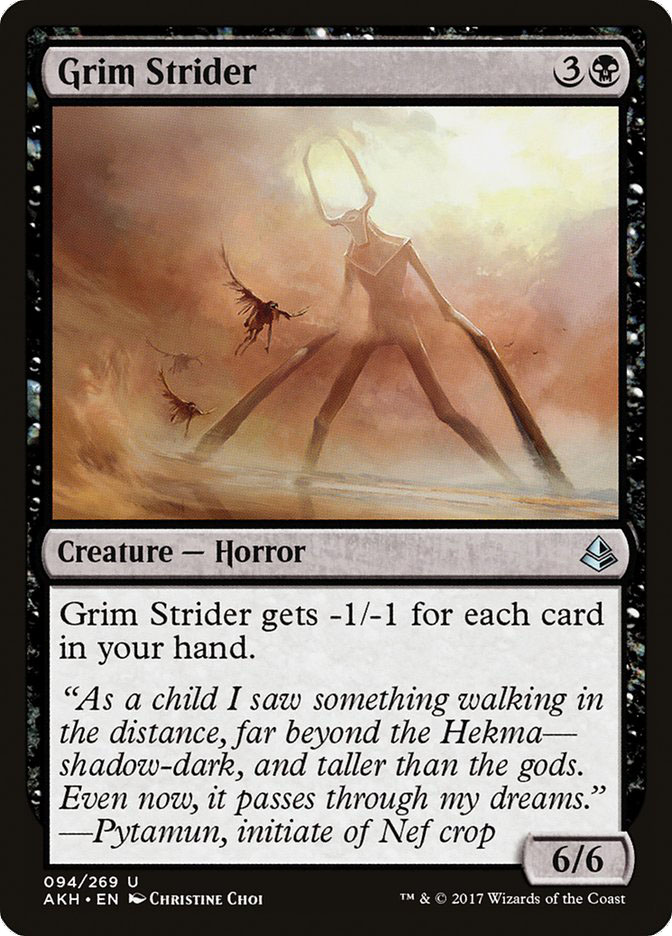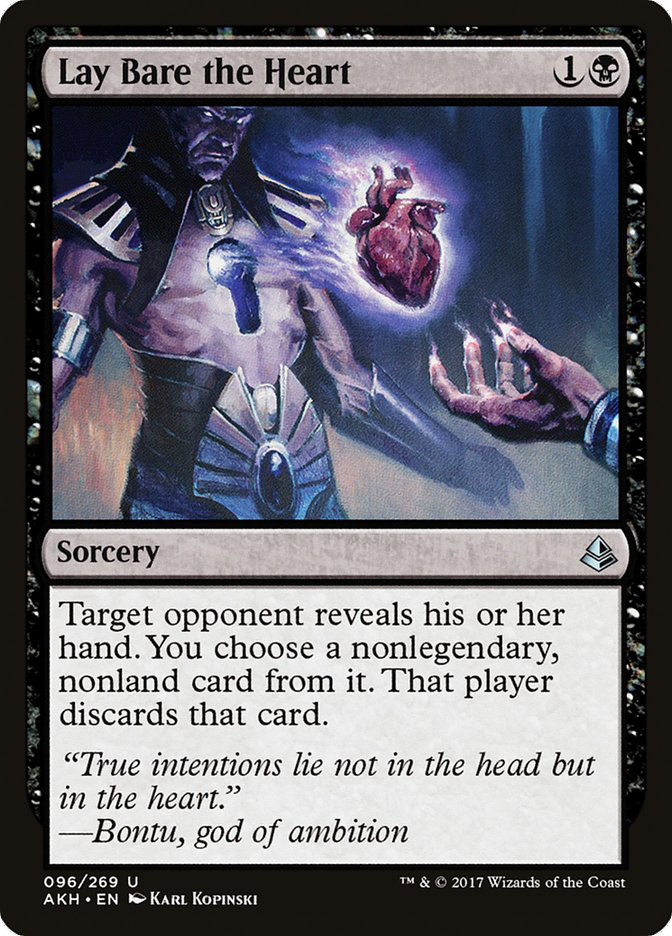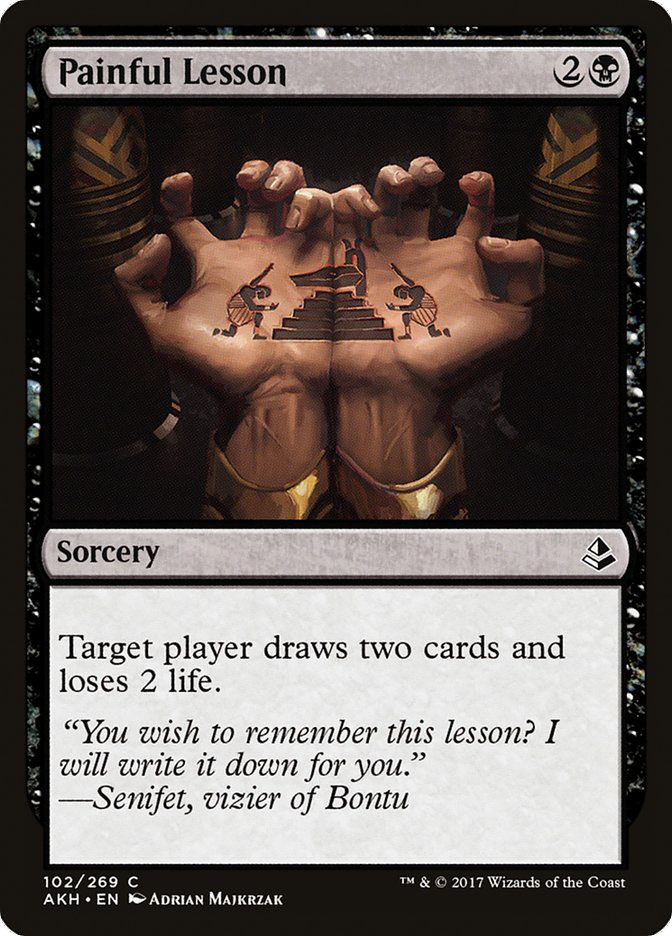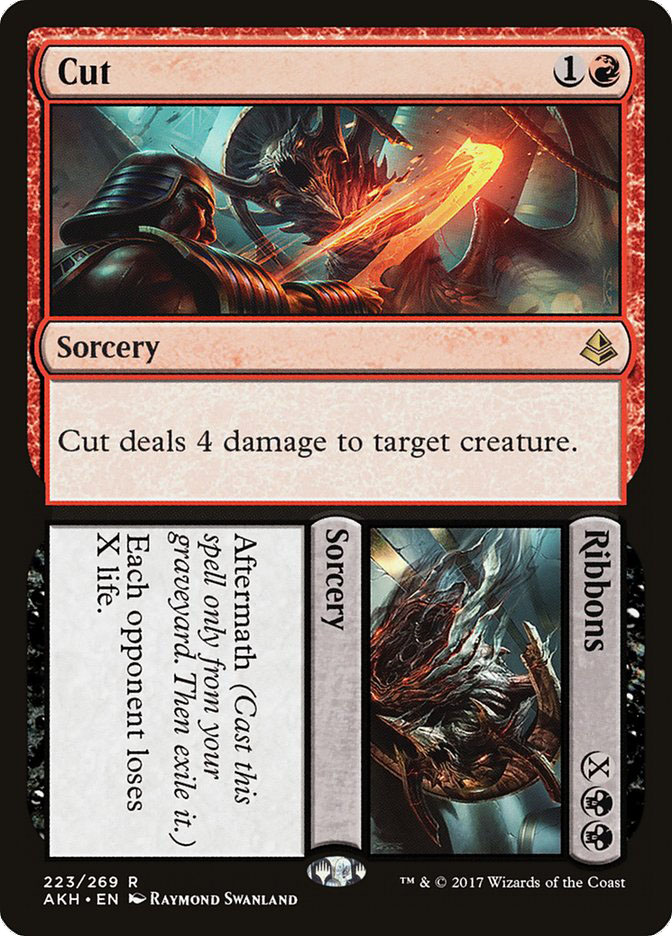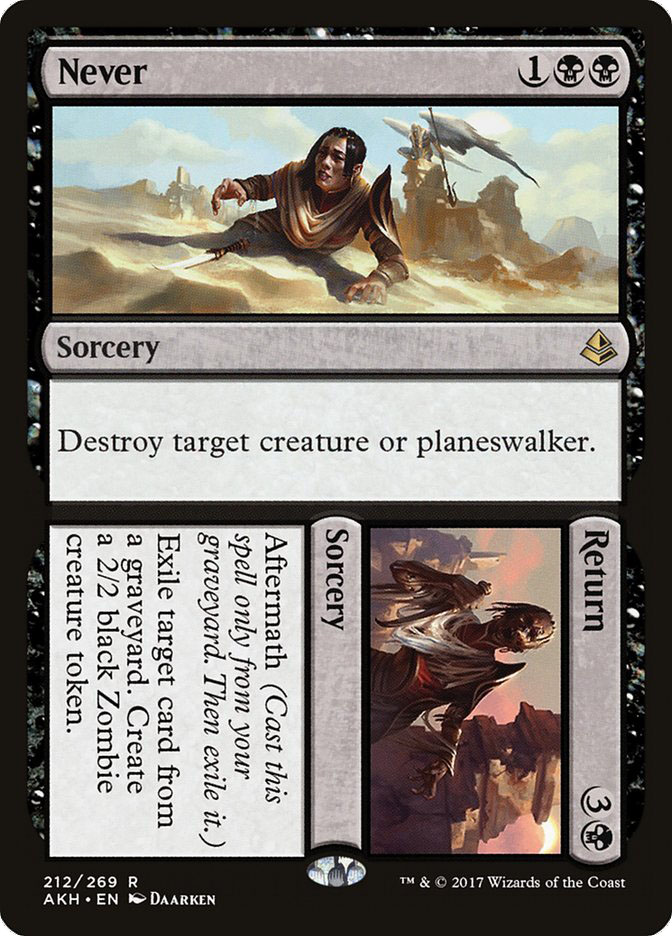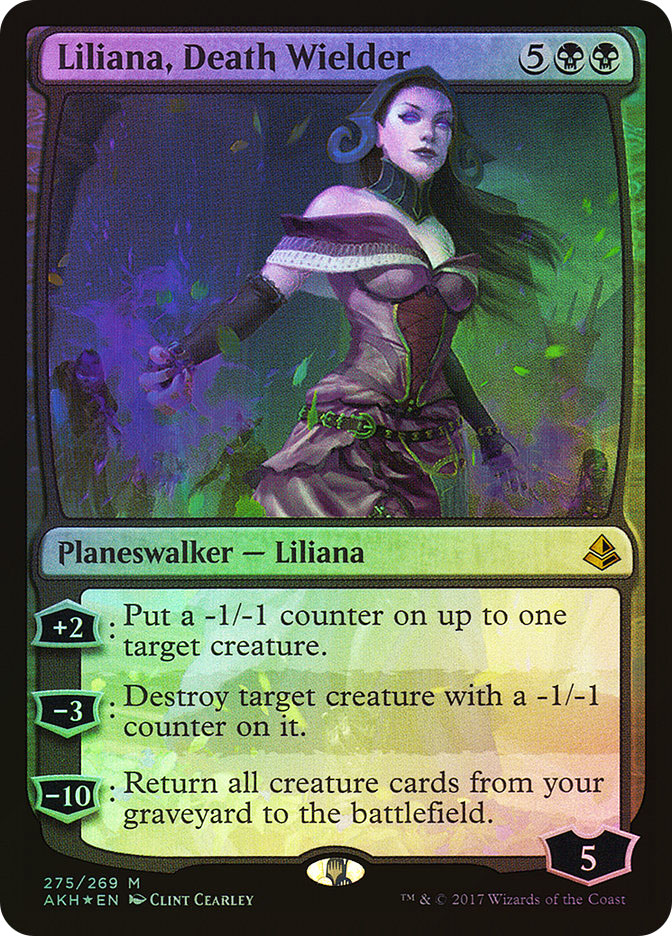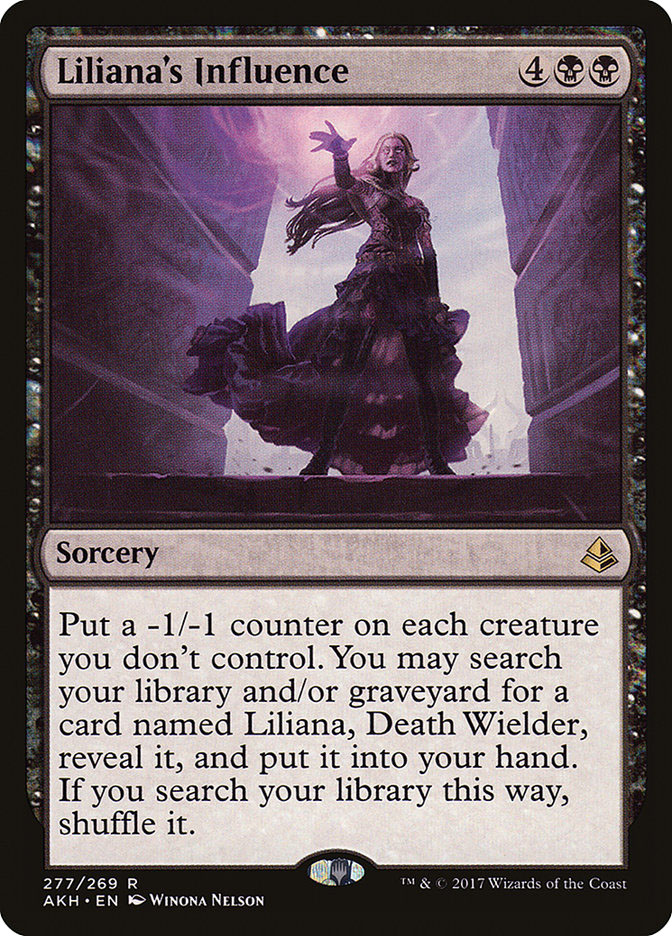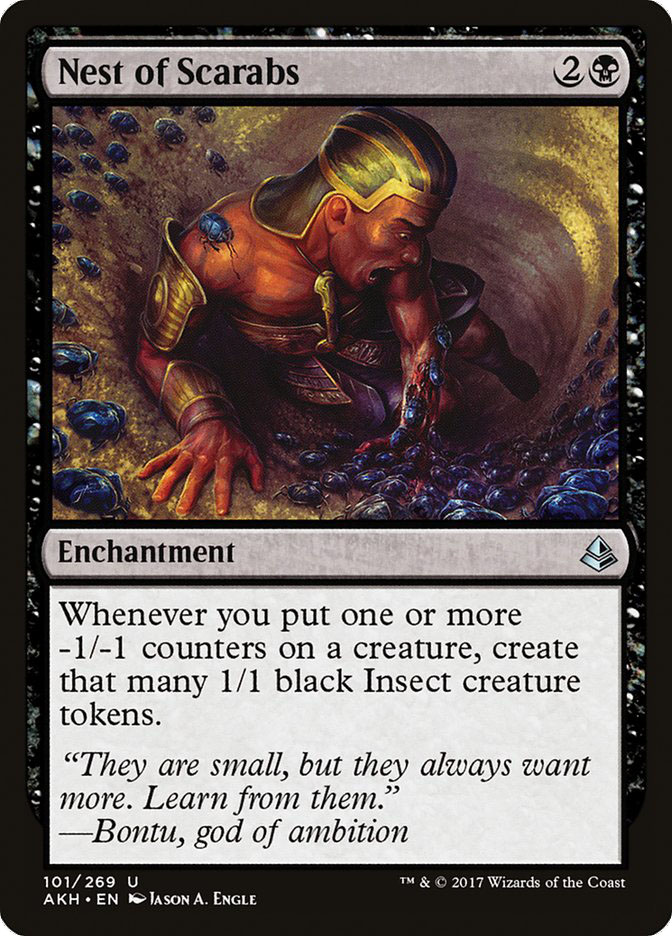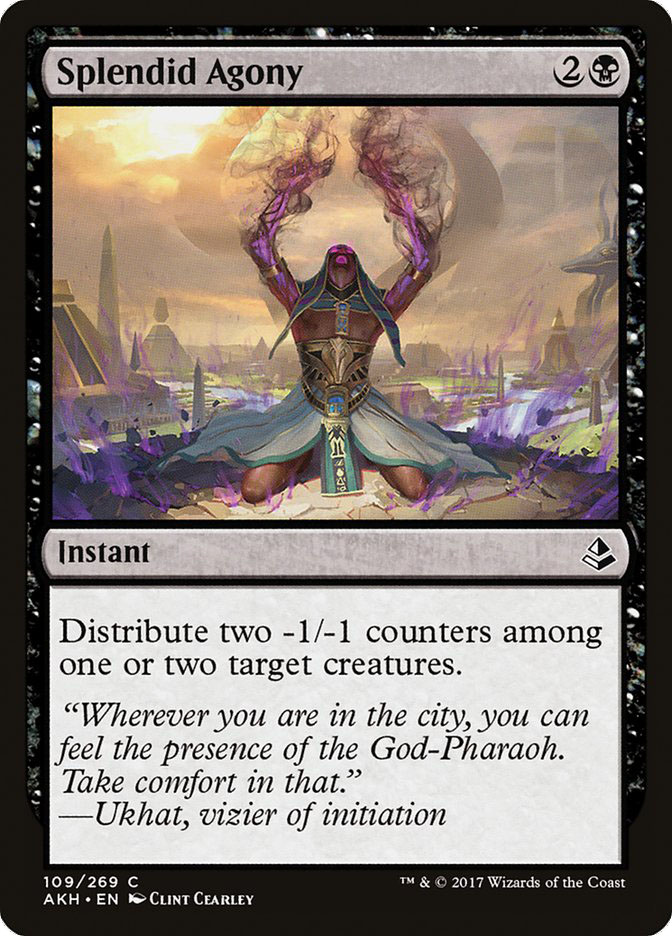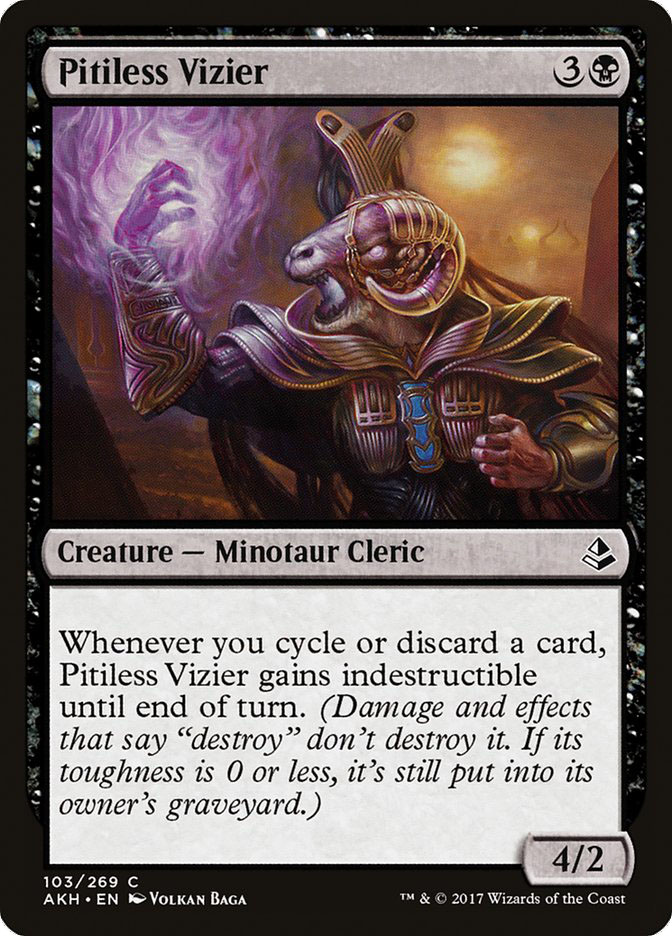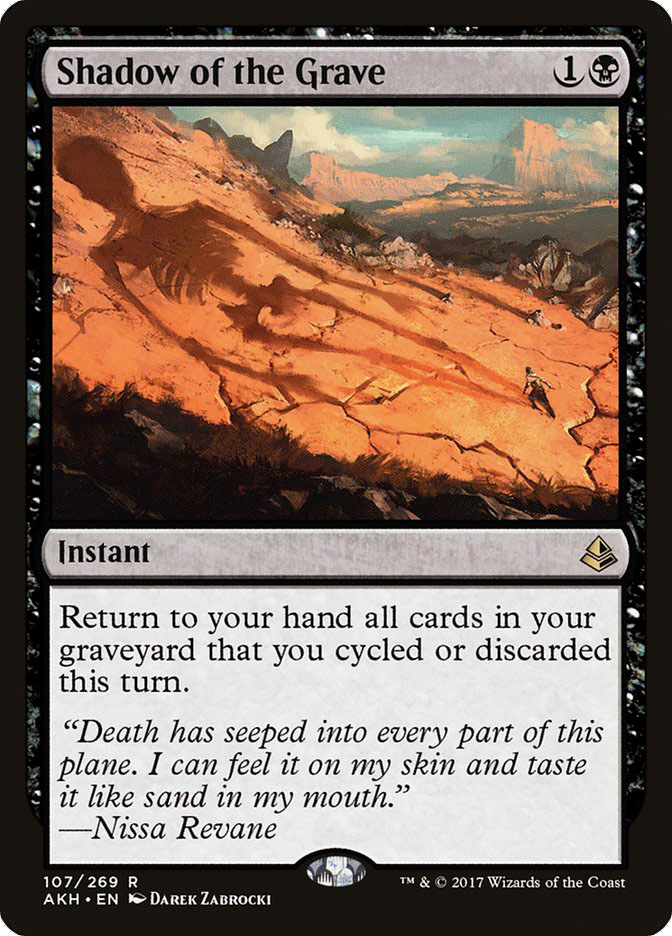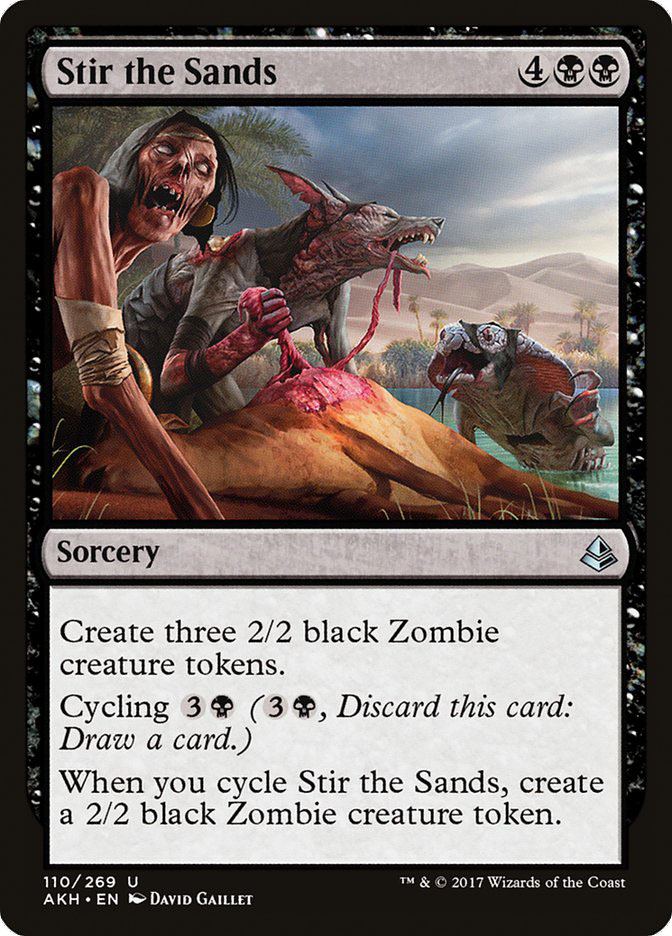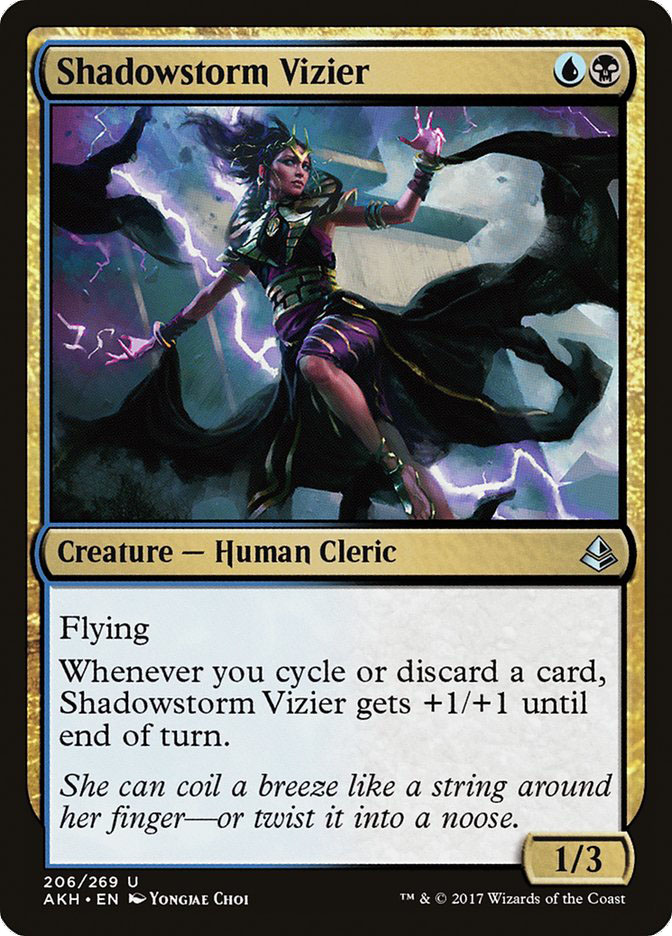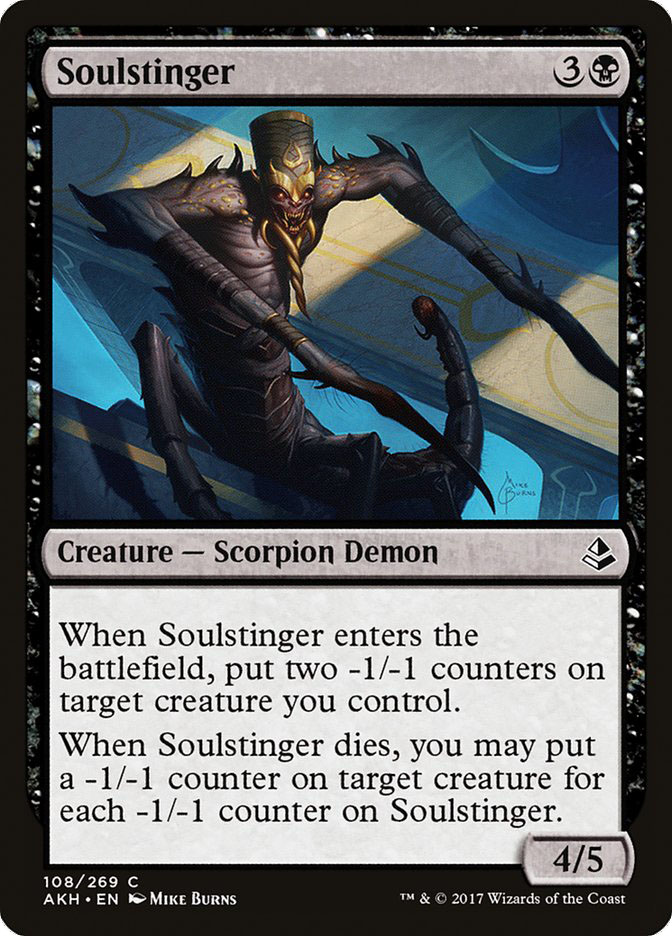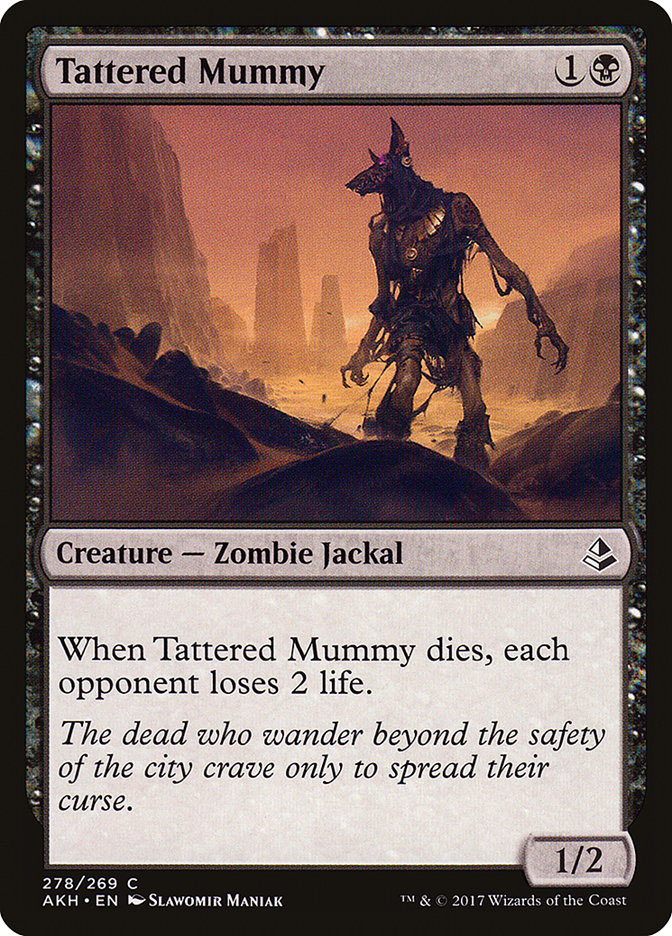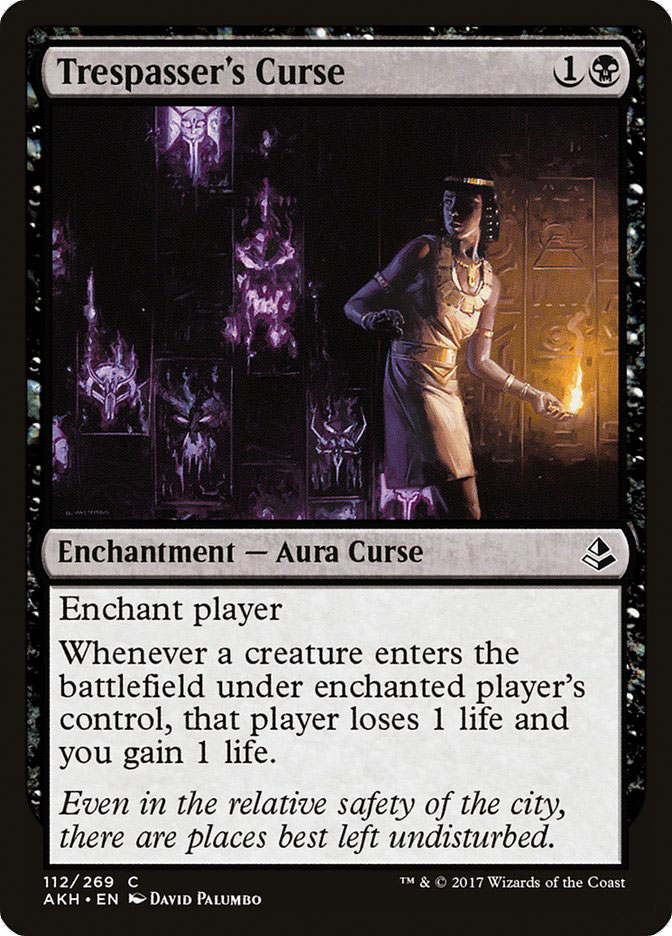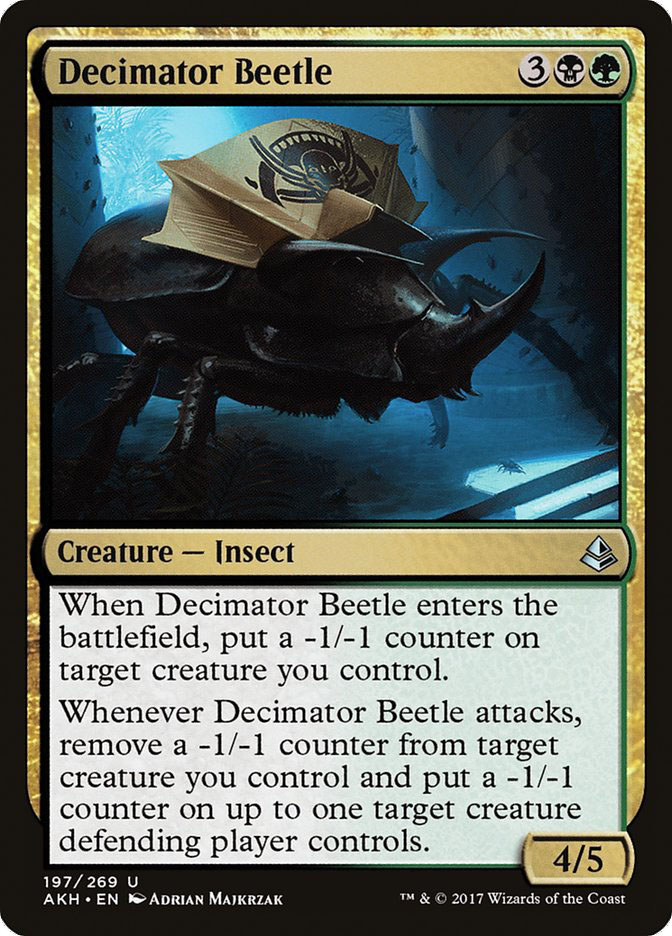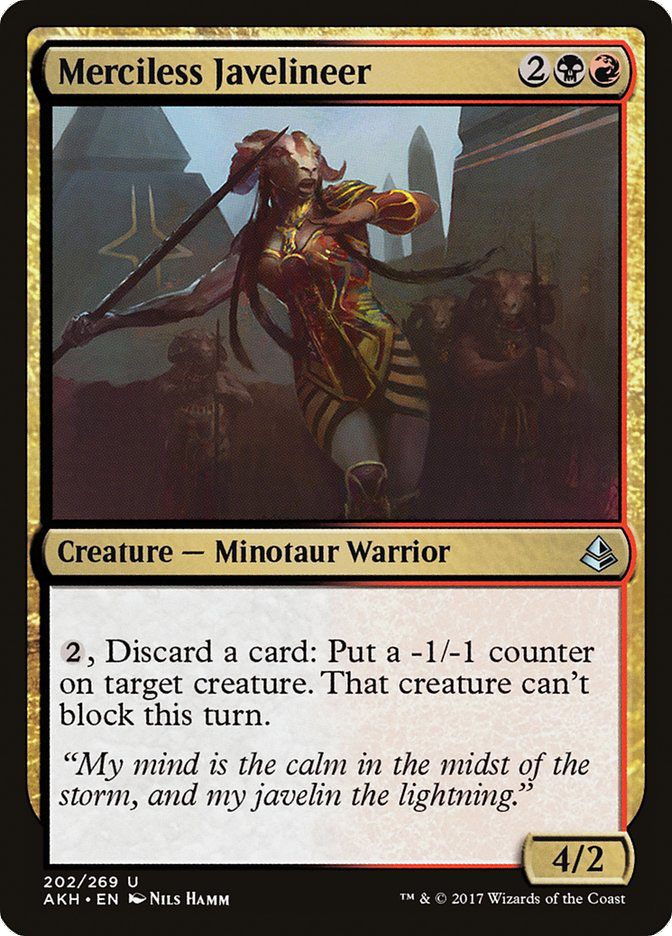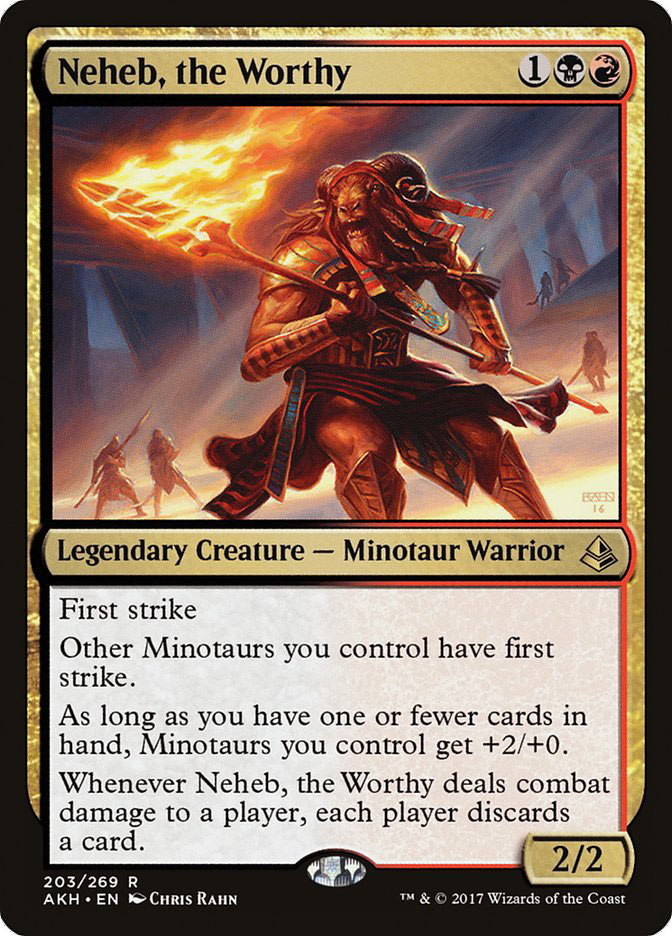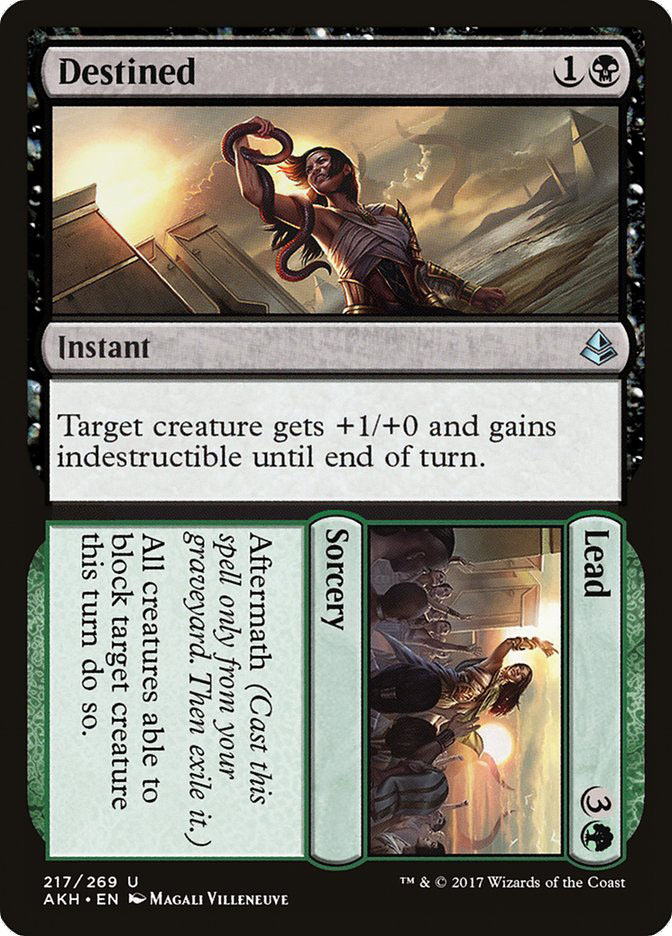Amonkhet is in full swing, so it’s time to get to work mastering the new cards. What interactions highlight them the best? Where can they best be used? What cards gain and lose value as a result? What do Amonkhet Standard decks look like?
Today, I’d like to start with the black cards…
Archfield of Ifnir is one of the most fascinating cards in the new set. It’s a major threat that can completely take over a game if it lives a turn. It doesn’t actually even cost that much mana, which means we can sometimes cast it and cycle something immediately. It synergizes with tons of cards, both old and new.
While there are many different directions to go (Combo, Reanimator, Control), here’s an attempt to go the straightforward route, sort of like how you’d imagine an Astral Slide / Lightning Rift deck being set up.
Creatures (12)
Lands (24)
Spells (24)

Archfiend of Ifnir is absolutely devastating in a deck like this. Everything that cycles is now effectively a one- or two-cost, instant-speed, uncounterable -1/-1 (permanently). That being said, there are going to be spots where we are pretty confident our opponent has removal in their hand, just waiting for a target.
While Drake Haven has gotten way more attention, I’m actually kind of more excited about Faith of the Devoted. There are many spots where the first couple of activations of Drake Haven are just turning on your opponent’s Fatal Pushes, their Shocks, their Unlicensed Disintegrations. It can still be a powerful tool for taking over the mid-game, but I wouldn’t be surprised if we want even less than this. With both requiring a mana to trigger, we do get diminishing returns from stacking up lots of these enchantments.
How many times a turn do we have to trigger Faith of the Devoted to really dominate the game? I mean, even just twice is a Soul Feast each turn. They aren’t going to be able to last long under those conditions and the extra life will make it harder to kill us.
Curator of Mysteries is another aggressive flying threat that can have a big impact on our card flow when we actually cast it. That being said, we’re probably going to cycle it 90% of the time in this list. Given that we’re cycling it that often, it’s not hard to see why Horror of the Broken Lands is also a worthy potential inclusion. We’re not planning on actually casting it; but when we pick our spots, it is kind of cool that the Horror typically kills in two hits.
Censor is decent anyway, and while I’m not the biggest fan of Hieroglyphic Illumination, once we’re in the market for anything that cycles for a single blue or black mana, it easily makes the cut. Of course, depending on how frisky we’re feeling, we could lean into one-cost cycling cards even more.
While River Serpent can attack and Scarab Feast can occasionally interact with graveyard recursion, cycling for just one mana is really important.
Corrupted Grafstone gets a big boost from all these one-cost cyclers, and when you’re planning on triggering Faith of the Devoted and Drake Haven, every mana means so much. As such, Scarab Feast gets the nod over more traditionally desirable effects with cycling costs of two.
Cards like Unburden still have a purpose; I just think it’s best used in a more “normal” deck, like Mind Rot has occasionally been used.
Wasteland Scorpion seems like mostly a Draft card, but basically every creature that cycles for two or less can’t be written off. Depending on what the graveyard incentives we end up wanting to play in certain combo decks, basically every one of them has a spot from time to time.
Wander in Death is kind of cute when you’re getting back cards you cycled earlier, but this isn’t the deck for that kind of “modest value.” If we want to get extra mileage out of the creatures we’re cycling, straight-up reanimation is more appealing.
An in-depth discussion of Liliana, Death’s Majesty can be found here. Basically, though, she’s got kind of a Gideon, Ally of Zendikar meets Ob Nixilis Reignited thing going on, with a real Rise from the Grave vibe to her. If you tick her up, she’s just got so much loyalty. If you tick her down, you can get back an Archfiend of Ifnir you cycled earlier and sort of do a pretty mean Bloodbraid Elf impression. Two threats this dangerous in the same turn? That’s definitely noteworthy.
Creatures (12)
Planeswalkers (3)
Lands (25)
Spells (20)

With Archfiend of Ifnir, Horror of the Broken Lands, and Curator of Mysteries, we’re definitely not short on potential Liliana targets, should we want them. Likewise, if we’re using a deck with Liliana, the Last Hope, we can now drop her turn 3 and be extremely likely to be able to go up a card from her -2, if we’re so inclined.
A lot of blue decks have struggled to reliably be able to turn Liliana, the Last Hope into a straight-up card drawer, making her more popular with green or white cards. Now, however, we’ve got tons of targets. For instance:
Creatures (11)
Planeswalkers (4)
Lands (25)
Spells (20)

Notice how much this isn’t even a full-on dedicated cycling deck. After all, there’s nothing that says we have to go all the way to Faith of the Devoted. What if we just want to play a U/B Control deck that happens to take advantage of Archfiend of Ifnir?
While this list makes much less effective use of Pull from Tomorrow than some decks will, it’s just a really attractive card (for people attracted to Sphinxes and their Revelation). There are still a couple of fancy interactions, though. For starters, Pull from Tomorrow’s discard triggers Archfiend of Ifnir. It’s funny, but sometimes, just Pulling for zero can be game-winning.
Casting Pull from Tomorrow on turn 4 might not seem that impressive, but what if we discard Torrential Gearhulk?
Now our turn 5 Liliana can put a Gearhulk onto the battlefield, replaying a Fatal Push or Grasp of Darkness. That’s three big plays on the same turn, and a monumental momentum shift.
Commit//Memory is a really weird card. Everyone’s comparing it to Venser, Shaper Savant, but it kind of reminds me of Cryptic Command with how versatile it is. It’s kind of a Counterspell and a Cast Out. As such, it’s an excellent target for Torrential Gearhulk to Flashback; but weirdly, you can also use Torrential Gearhulk to cast the Timetwister side of the card, Memory.
Normally, the danger with a card like Memory is that your opponent gets first crack at using the new cards when they untap. However, if you Torrential Gearhulk on turn 6, on your opponent’s end step, you then get to untap with a Gearhulk and a full hand (plus an eighth card for the turn). It can be really easy to overestimate Timetwister effects, but I think we’re going to see a lot more of this one. The opportunity cost is just so low, since we’re interested in Commit anyway, and this Torrential Gearhulk interaction is weirdly powerful.
Liliana, Death’s Majesty can be the backbone of an even more dedicated reanimator deck, if we are so inclined:
Creatures (13)
- 2 Ulamog, the Ceaseless Hunger
- 2 Kozilek, the Great Distortion
- 4 Archfiend of Ifnir
- 1 Desert Cerodon
- 4 Horror of the Broken Lands
Planeswalkers (4)
Lands (25)
Spells (18)

While we can just hang out, cycling Archfiends, Horrors, and Cerodons and then reanimating them, this list also has the ability to get Ulamog or Kozilek into the graveyard with Tormenting Voice, Cathartic Reunion, and Collective Brutality. Reanimating an Eldrazi turn 5 might not give us the double exile trigger or hand refill trigger, but they are both extremely powerful threats that win very quickly. Kozilek’s “discard to counter spells” ability even triggers our Archfiend!
Once we’re reanimating, it sure would be nice to get a certain young lady in there…
Nahiri, the Harbinger makes for an excellent curve into Liliana, Death’s Majesty, particularly if we cycle on turn 1 and Corrupted Grafstone on turn 2.
Creatures (9)
Planeswalkers (11)
Lands (24)
Spells (16)

This list is trying Emeria Shepherd, a reanimation target suggestion by Zvi Mowshowitz that can take over a fair number of battlefields while still being much more castable than the big Eldrazi.
The Winged Shepherds give us extra bodies to reanimate, giving us more options than Horror of the Broken Lands or Desert Cerodon would.
Gideon of the Trials is just an excellent card in its own right, but it also makes for a great lead into the Nahiri / Liliana line. It’s great to get to hold off whatever threat we want without spending mana each turn, setting up for a big Fumigate.
While Liliana, Death’s Majesty is typically going to really incentivize us to play with some creatures to potentially reanimate, that doesn’t have to be plan A or B. For instance:
Creatures (8)
Planeswalkers (11)
- 3 Gideon, Ally of Zendikar
- 2 Sorin, Grim Nemesis
- 1 Liliana, the Last Hope
- 3 Gideon of the Trials
- 2 Liliana, Death's Majesty
Lands (26)
Spells (15)

Liliana, Death’s Majesty and Gideon of the Trials add a substantial amount of power to W/B Planeswalker decks, but Sorin, Grim Nemesis also benefited a fair bit from Amonkhet.
Sorin’s +1 ability scales proportionately to the printed converted mana cost of our cards. Archfiend of Ifnir, Winged Shepherd, and Cast Out all cost a lot, despite typically being cycled for very little mana. More than a third of the time you activate Sorin, you’re going to be going upstairs for four or more when you draw the extra card.
You’re probably going to have to be very into putting -1/-1 counters on your creatures to make Baleful Ammit worth it, especially since it’s not a Zombie. It’s not an embarrassing rate, so maybe there’s a place for it in some Hapatra, Vizier of Poisons deck. However, it wouldn’t be in my first build. The body’s a little inconveniently set up, and we’ve just got so many good options.
Blighted Bat is basically just a Draft card, though it is interesting that it’s a flying Zombie, as they are a tribe that doesn’t traditionally fly.
When things are going right, Bone Picker is a 3/2 flier for one, like Delver of Secrets. When they’re not as good, Snapping Drake.
That’s great potential, well worth working on. The natural starting point is some kind of a W/B or G/B deck with sacrifice outlets. For instance:
Creatures (28)
- 3 Carrier Thrall
- 4 Zulaport Cutthroat
- 2 Ayli, Eternal Pilgrim
- 1 Archangel Avacyn
- 2 Yahenni, Undying Partisan
- 4 Sacred Cat
- 4 Dread Wanderer
- 2 Bontu the Glorified
- 4 Bone Picker
- 2 Festering Mummy
Planeswalkers (4)
Lands (23)
Spells (5)

This style of deck sure does seem to re-emerge a lot these days.
Bontu the Glorified is less impressive than Rhonas the Indomitable or Hazoret the Fervent, but it’s still a four-power menace threat that gives us lots of options. It’s kind of a reward for using sacrifice outlets, can be a sacrifice outlet itself, gives us some reach, some lifegain, and some card flow. It isn’t really exceptional at much, but it does so many things, they can start to add up.
Maybe we should be playing Doomed Dissenter, but there’s only so much space, and I kind of think all of the other two-drops are doing more for us. After all, it really is just a less fancy Sultai Emissary. Maybe if we had more Zombie synergies.
Start//Finish might be interesting in some kind of version of this deck, but I think you’d probably have to both value tokens (with a bunch of Anthems) and the option to buy a kill spell later. The card seems fine on rate, but it might be awkward in practice, as you need to be taking advantage of a lot of different things to want this.
Depending on what the format ends up looking like, we could easily be in the market for more copies of Festering Mummy. Remember, a -1/-1 counter is a meaningful upgrade over just -1/-1 until end of turn.
Dread Wanderer is outrageously strong, a really big influencer in the format. Tormented Hero was a very similar design, being a one-cost 2/1 that entered the battlefield tapped. Unlike Tormented Hero, however, Dread Wanderer actually has an amazing ability. In fact, it and Lord of the Accursed give Zombies enough tools to be truly Tier 1, in my estimation.
Lord of the Accursed isn’t the powerhouse Dread Wanderer is, but it’s fine if we’re dedicated to Zombies. The menace ability doesn’t get used all that much, but the option can sometimes force our opponents to have to play in ways they’d rather not.
Creatures (26)
- 4 Relentless Dead
- 4 Diregraf Colossus
- 4 Cryptbreaker
- 4 Lord of the Accursed
- 4 Plague Belcher
- 4 Dread Wanderer
- 2 Festering Mummy
Lands (23)
Spells (11)

Make no mistake: Zombies won’t be just some fringe strategy. There is enough support now, and Diregraf Colossus and Dark Salvation are going to be simply incredible.
Diregraf Colossus is a very impressive tribal lord now that there’s a good mix of Zombies. If it lives, the battlefield advantage it provides gets very silly quickly. Remember, it makes the 2/2s even if the Zombie you cast is countered.
Dark Salvation can be a one-mana removal spell, but is more commonly played for three or five mana, killing an opposing threat while efficiently advancing the battlefield. Dark Salvation’s template is very bizarre, but one consequence is that you can play it into an empty battlefield when facing an opponent without creatures to target.
Plague Belcher is an exciting threat that requires a little finesse to really maximize. You gotta put the -1/-1 counters on something. Here are some ways to get more than the sum of the parts:
- Relentless Dead – Put the counters on Relentless Dead and it’ll die. Pay a B and you’ll get the Dead back. Pay more and you can reanimate another Zombie.
- Lord of the Accursed – While the -2/-2 leaves the Lord of the Accursed likely to be unable to deal damage, it might just want to stay out of harm’s way anyway. You can even activate its menace ability if the Lord gets restless.
- Dread Wanderer – The counters will kill the Dread Wanderer, generally speaking, but that’s only a temporary delay.
- Festering Mummy – Killing the Mummy lets us use it proactively as removal!
- 4 Relentless Dead
- 4 Diregraf Colossus
- 4 Cryptbreaker
- 2 Lord of the Accursed
- 1 Plague Belcher
- 4 Dread Wanderer
- 4 Wayward Servant
- 4 Relentless Dead
- 4 Diregraf Colossus
- 4 Prized Amalgam
- 4 Haunted Dead
- 4 Cryptbreaker
- 4 Scrapheap Scrounger
- 4 Dread Wanderer
- 1 Miasmic Mummy
- 4 Lupine Prototype
- 4 Cryptbreaker
- 4 Scrapheap Scrounger
- 2 Hazoret the Fervent
- 2 Flameblade Adept
- 4 Dread Wanderer
- 4 Bloodrage Brawler
- 2 Archangel Avacyn
- 4 Thraben Inspector
- 2 Thalia, Heretic Cathar
- 4 Scrapheap Scrounger
- 4 Toolcraft Exemplar
- 4 Dread Wanderer
- 4 Crocodile of the Crossing
- 4 Channeler Initiate
- 4 Exemplar of Strength
- 4 Hapatra, Vizier of Poisons
- 3 Manglehorn
- 4 Plague Belcher
- 4 Archfiend of Ifnir
- 4 Crocodile of the Crossing
- 4 Channeler Initiate
- 2 Exemplar of Strength
- 4 Hapatra, Vizier of Poisons
- 4 Plague Belcher
- 4 Ruthless Sniper
- 4 Archfiend of Ifnir
- 4 Curator of Mysteries
- 3 Horror of the Broken Lands
- 4 Shadowstorm Vizier
- 4 Ruthless Sniper
- Turn 1 – Flameblade Adept.
- Turn 2 – Noose Constrictor.
- Turn 3 – Shadow of the Grave.
Liliana’s Mastery is a little expensive, particularly when we’re interested in potentially playing Dark Salvation for five mana. That said, it is 6/6 of stats to start with, and the tribal Anthem is frequently going to give us another +4/+4 or more worth of stats.
I’m not sure if Sunscorched Desert is really worth it over Westvale Abbey, but it seems worth a shot. The extra life loss costs us so little.
Yeah, I know it has the word Zombie on it, but we’ve got to have better things to spend our mana on most of the time, right?
Wayward Servant’s ability is a very appealing potential addition to a Zombie deck. We’ve even got a hole at the two-spot for when we’re not Relentless Deading or Cryptbreaking. The challenge is that there are only two good W/B lands to help pull off the mana.
Creatures (23)
Planeswalkers (4)
Lands (22)
Spells (11)

There’s a lot to like with this direction, but there’s also still a lot of room for customization and tuning. For instance, how much removal do we need? How much can we lean into In Oketra’s Name?
It is a lot of damage for only a little mana, but every non-Zombie card comes at a premium.
Gravedigger has shown up before, but it’s been a while. The format doesn’t seem like it’s really going to be about this modest but inevitable grinding. Rather, the format seems about setting up devastating plays.
Definitely not an embarrassing two-drop option, if we’re really into staying mono-black but want another two-drop. Of course, we could just play some Scrapheap Scroungers if we’re not afraid of Manglehorn.
Creatures (29)
Lands (22)
Spells (9)

Once we’re getting into Prized Amalgam territory, we should probably try Supernatural Stamina. Worse versions of this trick have shown up before, and not only do we get any enters-the-battlefield triggers (such as a larger Diregraf Colossus), but the creature coming back triggers our Prized Amalgams.
I wonder if evoke is coming back soon?
Dread Wanderer is absolutely excellent in a Zombie deck, but it doesn’t have to be confined to just that one role.
Creatures (24)
Lands (22)
Spells (14)

Lupine Prototype is a particularly interesting card after Amonkhet.
There are a bunch of cards that do something special when you have one or fewer cards in hand. That’s very much up Lupine Prototype’s alley!
It’s not a perfect fit, but maybe Dread Wanderer is powerful enough to find a home in Mardu Vehicles. It can’t crew a Heart on its own, but it’s still a very aggressive threat that would help give us even more resilience to removal.
Creatures (20)
Planeswalkers (4)
Lands (23)
Spells (13)

Cartouche of Ambition is expensive and unwieldy, the least exciting of all the Cartouches. That seems only fair, seeing as black’s Trial is probably the best of all the Trials.
A Cruel Edict is already interesting for two mana, and then we get the option to rebuy it later when we cast Cartouche of Solidarity, Cartouche of Zeal, or Cartouche of Knowledge. Additionally, it has a variety of synergies Cruel Edict could never do, like Felidar Guardian giving you another Edict or Oath of Nissa being able to find it.
The topic of Cartouches and Trials is a deep one that I’d like to revisit on Wednesday, as it’s hard to talk about any of them without really diving into all of them.
Cruel Reality might be kind of interesting if there’s a way to cheat the cost of Auras in an upcoming set. It’s hard to imagine what the deck would look like, but if we had some kind of Open the Armory deck that went a little bigger and was in the market for a toolbox, you could run one of these as a finisher. Generally speaking, Cruel Reality is too expensive to just run without any synergies.
In times long past, this could have been an interesting tribal choice, but there are far, far too many good three-drops and no shortage of good Zombies now.
Desiccated Naga is a preconstructed deck card that’s too fragile, too inefficient, and too unreliable.
How many Cranial Extractions will ever be enough?
Dispossess looks a little goofy, but being able to hit Torrential Gearhulk, Aetherworks Marvel, and Dynavolt Tower insures the card will find a home in some sideboards. It also means decks built around those cards may want to diversify a little more than they used to.
Dune Beetle raises an eyebrow with the mild stat inflation, but at the end of the day, it’s not actually more rate than the 2/3s for two that are out there. It’s not out of the question, but it’s still not likely that we’ll be in the market for this one. Maybe if we’re really valuing the extra toughness because of having sweepers that deal three or give -3/-3.
Draft card. We can and must do so, so much better in Constructed. The creatures people play in Constructed tend to have a lower converted mana cost on the average than in Draft. As such, the removal needs to be cheaper as well, or else we’re paying more to remove something than it cost to cast (usually a bad sign).
Super-unlikely. It could have literally no drawback at all, and it might not be good enough, given its lack of versatility and options. Any cards in hand at all, and quickly the card becomes very unattractive for high-level Constructed.
A reasonable option, I think Lay Bare the Heart is mostly a modest upgrade over Transgress the Mind (a decent, not great card itself). Lay Bare the Heart will get played, but probably out of necessity rather than power level.
Creatures (8)
Planeswalkers (6)
Lands (26)
Spells (20)

Live Fast isn’t exactly defining the format, but if you don’t care about energy, Painful Lesson is a Live Fast with the option to go upside your opponent’s head when the situation calls for it.
Flame Slash for two is playable in a lot of formats. Then, on top of that, we get a finisher sitting there, building up over time as we draw more lands.
A decent upgrade to Ruinous Path. Even when you’ve got seven mana, Ruinous Path is only slightly better. However, in the many turns earlier, Ruinous Path just goes away, while Never//Return gives us another game piece when we’ve got nothing better to do. It also gives us some valuable assistance against Scrapheap Scrounger and the various Zombies.
Here’s another possible home for Never//Return:
Creatures (4)
Planeswalkers (2)
Lands (26)
Spells (28)

I think Flaying Tendrils has gotten a lot stronger with the addition of Amonkhet. The format seems even faster than the last one, and Flaying Tendrils is particularly strong against Dread Wanderer and company.
Liliana, Death Wielder is a preconstructed deck card that costs too much for competitive tournament play. Seven mana is a big ask when Chandra, Flamecaller and Sorin, Grim Nemesis cost six. In reality, we would probably not be in the market for this at five.
If Liliana’s Influence gave you a full-on Diabolic Tutor after the -1/-1 counters, maybe we’d have something to talk about. As it stands, only finding an extremely inefficient seven-cost planeswalker is nowhere close to good.
Nest of Scarabs is an unusual card that makes us care about very different things from what we normally would. In a way, it really is a -1/-1 counter “lord.” If we play both it and Hapatra, Vizier of Poisons, we might just start by looking for every black and green card in the set that gives -1/-1 counters (and, for reference, there are no -1/-1 counters in the previous six sets).
Creatures (23)
Lands (25)
Spells (12)

Being an instant with a permanent effect, able to be split up, and having some synergies, Splendid Agony might actually be worth a shot. It does have a giant blind spot to Felidar Guardian, though.
While we’d have to make a few adjustments to the deck, Ruthless Sniper actually seems pretty interesting to me. The -1/-1 counters at instant speed could make combat an absolute nightmare for our opponents.
Creatures (26)
Lands (24)
Spells (10)

I’m not sure it’s realistic to play a deck like this if Felidar Guardian is legal, but maybe we can add a few Manglehorns and a few Grasp of Darknesses and get a passable enough Game 1 to sideboard into a sufficiently ready build after sideboarding.
Draft card.
Shadow of the Grave has a pretty high ceiling, but you probably have to be doing something really busted, or else it’s a fairly inefficient card drawer.
Creatures (12)
Lands (25)
Spells (23)

This list seeks to go full-on Fluctuator. Weirding Wood and Shefet Monitor help us play New Perspectives ahead of schedule, and then future Monitors and Viziers of Tumbling Sands actually net us a little mana while we’re cycling. Vizier of Tumbling Sands is particularly strong when untapping a land with Weirding Wood on it.
Then, after we go as far as we can, we Shadow of the Grave and hopefully then are able to draw enough cards to draw our entire deck (or as much of it as we want).
It’s probably just better to play more Cast Out types, but the thinking is that New Perspectives lets us skip the full mana cost of our cycling, so this is a way to get extra value. I’m really not sure if we’re supposed to plan on just winning the moment we drop New Perspectives or not. I’ve got a feeling the final answer will be either yes (and we move way from Stir the Sands) or no (and we move more towards it). Splitting the difference is probably not going to pan out.
Shadowstorm Vizier takes the cycling strategy into a more aggressive direction. We’ll be talking more about such paths when we look at blue, but here’s a possible New Perspectives list with the Vizier as a starting point:
Creatures (19)
Lands (25)
Spells (18)

There is one other Shadow of the Grave deck I wanted to put a prototype out there for, though I’m hoping to have a better version later this week.
Creatures (20)
Lands (23)
Spells (17)

This list is trying to build around the sequence of:
That’s twenty damage right there, and Insult//Injury is pretty effective at leading to some early kills itself. More to come on this strategy.
Draft card.
It is a Zombie and has an ability that synergizes with some of the other stuff, but the rate is just nowhere close. Just compare it to Miasmic Mummy.
Kind of a cute answer to Felidar Guardian, Trespasser’s Curse is a totally reasonable sideboard card with some cool interactions with cards like Sram, Senior Edificer; Open the Armory; and Sigarda’s Aid.
Draft only.
Draft only.
Neheb, the Worthy is respectable, but I don’t think there are really enough good Minotaurs yet. This will be a powerful lord when there are, though. It seems like they’re going to print plenty of Minotaurs over the next year and a half, so things will hit max Minotaur relatively shortly before Neheb rotates out.
Seems awesome in Draft, but not likely to be what G/B is looking for in Constructed.
This is an expensive way to do it, and I’m guessing Flaying Tendrils is better for sweeping. When you can actually afford to take -2/-2 instead of -3/-3, you typically value saving the mana a lot, plus exiling is a big game.
Okay, obviously this has been a ton already, and there’s still so much more to cover. I’ll be back Wednesday, continuing an exhaustive look at Amonkhet. See you then!


